

























WWW.LACTALISFOODSERVICE.CA @LACTALISCANADAFOODSERVICE Let’s connect TM Find us online for mouth-watering inspiration! 19% M.F. Pizza Mozzarella From a Brand You Trust Shorten kitchen prep time and maximize melt. Try Cracker Barrel Pizza Mozzarella today! Available Now!





SEPTEMBER 2023 FOODSERVICE AND HOSPITALITY 1 FOODSERVICEANDHOSPITALITY.COM VOLUME 56, NO.6 | SEPTEMBER 2023 DEPARTMENTS 2 FROM THE EDITOR 5 FYI 10 SERVING QUALITY IN FOODSERVICE 60 CHEF'S CORNER Hans Vogels, DASHA, Toronto THE CHALLENGES & OPPORTUNITIES ISSUE 60 CHALLENGES & OPPORTUNITIES 27 BELABOURING THE ISSUE A shift in thinking is needed to address the labour crisis 29 STRIKING A BALANCE When it comes to third-party delivery, operators struggle to find the balance 31 GETTING GHOSTED Ghost kitchens offer new opportunities for brick-and-mortar operators 33 ACCESSIBLE SOLUTIONS Making restaurants accessible to all is key to universal design 38 CHANGING THE NARRATIVE Recognizing the ROI of mental-health support for restaurant employees is key to driving change 42 THE LIVING LAB The Living Lab tackles food waste at Conestoga College 46 A SLICE OF STYLE Equipment options abound for today’s pizza makers 50 THE COFFEE & TEA REPORT New opportunities flourish in the coffee-and-tea segment FEATURES 11 DIGGING DEEP High-performing leaders move out of the past and into the future 13 WEIGHING THE OPTIONS Several crucial factors restaurant owners should consider before franchising 16 THROUGH THICK AND THIN Pizza and pasta stand the test of time 50 29
Restaurants have undergone a world of transformative change in recent years due to the pandemic. And though many are now enjoying solid business, a host of seismic changes will forever change the way restaurants operate. Add demographic changes to the mix, and it’s clear the restaurant landscape is more dynamic than ever.
According to a recent study of millennial and Gen Z consumers, undertaken in the U.S. by Y-Pulse, (a division of Olson Communications), young adults are fuelling a food culture driven by convenience. The study revealed three key findings on dining behaviour:

CONVENIENT LIFESTYLE DINING: Breaking bread together has always been viewed as a way of bringing people together, but the young adults who participated in the Y-Pulse survey provided a fresh perspective on this maxim, with 72 per cent reporting that sharing a meal with a friend or family member in the car suits their hectic lifestyle.
We’ve heard about dashboard dining for several years, but this young generation takes it to a new level, with Tik-Tok popularizing extreme in-car cooking among friends. With the
SETTING THE TRENDS
variety of foods available from QSR restaurants, the study indicates that “the drive-thru may become a new venue for culinary exploration.”
CONVENIENT CAFE CUISINE:
Interestingly, the study also found that convenience stores, which might have been considered little more than a fuel stop a decade ago, are becoming adult-friendly gathering places. Keep in mind this may be more of an American trend than a Canadian one. The study found that 77 per cent of survey participants, said they like convenience stores that feature café seating. Food halls and marketplaces are also attracting young adults because they “offer a world of choices through the wide range of vendors.” In fact, 81 per cent of survey participants favoured food halls, which “make it easy and convenient for a group of friends with diverse tastes to dine together.” A total of 88 per cent of participants liked “food markets because of the ease of sharing a meal with others when not everyone in the party wants the same type of food.”
CONVIVIAL TO-GO EXPERIENCES: In a similar vein, 71 per cent of Millennial and Gen Z consumers surveyed preferred meals they can consume on the go. Yet, that doesn’t necessarily mean they’re consuming those meals alone. A total of 91 per cent enjoyed sharing meals with other people rather than dining alone while 87 per cent reported they enjoy taking their to-go meal somewhere else to relax and enjoy with others.
Finally, of note, six years ago when young consumers were asked whether they preferred convenience versus cuisine, 44 per cent reported convenience as more important than cuisine in their dining decisions. That figure rose to 59 per cent in the latest study, proving that for today’s young consumers, it’s all about convenience. FH
ROSANNA CAIRA
@foodservicemag
facebook.com/foodservicehospitalitymagazine instagram.com/rosannacaira
2 FOODSERVICE AND HOSPITALITY SEPTEMBER 2023 FOODSERVICEANDHOSPITALITY.COM FROM THE EDITOR
NICK WONG, LOCATION PROVIDED BY VIA CIBO
EDITOR & PUBLISHER ROSANNA CAIRA
MANAGING EDITOR AMY BOSTOCK
ASSISTANT EDITOR NICOLE DI TOMASSO
ART DIRECTOR COURTNEY JENKINS

DESIGN ASSISTANT JENNIFER O’NEILL
SOCIAL MEDIA MANAGER JANINE MARAL
WEBSITE MANAGER TYLER BECKSTEAD
EVENTS MARKETING MANAGER JHANELLE PORTER
DIRECTOR OF BUSINESS DEVELOPMENT


















WENDY GILCHRIST
ACCOUNT MANAGER CATHI KREWICKI
ADMINISTRATIVE ASSISTANT DANNA SMITH
ACCOUNTING SERVICES DANIELA PRICOIU
CIRCULATION PUBLICATION PARTNERS
ADVISORY BOARD




ASCARI HOSPITALITY GROUP JOHN SINOPOLI
BROWNS RESTAURANT GROUP BRUCE FOX
BELLHOUSE HOSPITALITY INC. SCOTT BELLHOUSE

CHARCUT RESTAURANT CONNIE DESOUSA, JOHN JACKSON
LACTALIS CANADA IVEN ZANARDO
MAPLE LEAF SPORTS & ENTERTAINMENT DAN MORROW
MTY GROUP MARIE-LINE BEAUCHAMP
CHEF NED BELL
PARAMOUNT FINE FOODS MOHAMAD FAKIH
SOTOS LLP ALLAN DICK



















THE HOUSE OF COMMONS JUDSON SIMPSON
UNIVERSITY OF GUELPH, SCHOOL OF
FOODSERVICEANDHOSPITALITY.COM
HOSPITALITY
TOURISM
subscribe to F&H, visit foodserviceandhospitality.com Published eight times per year by Kostuch Media Ltd., Mailing Address: Kostuch Media Ltd., 14 – 3650 Langstaff Rd., Ste. 33, Woodbridge ON L4L 9A8 Tel: (416) 447-0888, Fax (416) 447-5333, website: foodserviceandhospitality.com. The reproduction of this magazine, in whole or in part, is expressly prohibited without the permission of the publisher. Copyright Foodservice and Hospitality magazine © SUBSCRIPTION RATES: 1-year subscription, $27.50; U.S. $55; International, $65. Canada Post – “Canadian Publication Mail Product Sales Agreement #40063470.” Postmaster send form 33-086-173 (11-82). RETURN MAIL TO: Publication Partners, 1025 Rouge Valley Dr., Pickering ON L1V 4N8 Member of CCAB, a Division of BPA International. Printed in Canada on recycled stock. EST. 1968 | VOLUME 56, NO 6 | SEPTEMBER 2023 Have the top business headlines conveniently delivered to your inbox every Tuesday & Thursday morning Hospitality Headlines SUBSCRIBE FOR FREE TODAY READ SHARE SUBSCRIBE Subscribe for FREE today! foodserviceandhospitality.com/newsletter/
&
MANAGEMENT BRUCE MCADAMS GARLAND CANADA MARY CHIAROT To
Peace of Mind
Elevate your business with Flanagan Foodservice, the largest Canadian owned food distributor. Whether you’d like to refresh your menu or give it a complete overhaul, we have the insight, experience, and products to support you and help your business thrive.

From farm-fresh produce to premium meats and everything in between, Flanagan Foodservice offers





a wide variety of affordable and high-quality products to meet your unique needs. We aim to simplify the process, providing peace of mind as we help drive your business forward.

Contact us today and talk to one of our foodservice experts who will help spark creative ideas and collaborate with you toward achieving your success.



Scan to learn more or visit flanagan.ca
1-800-265-6550

® DELIVERING
NEW KID ON THE BLOCK
Oliver & Bonacini Hospitality set to introduce Léo early next year
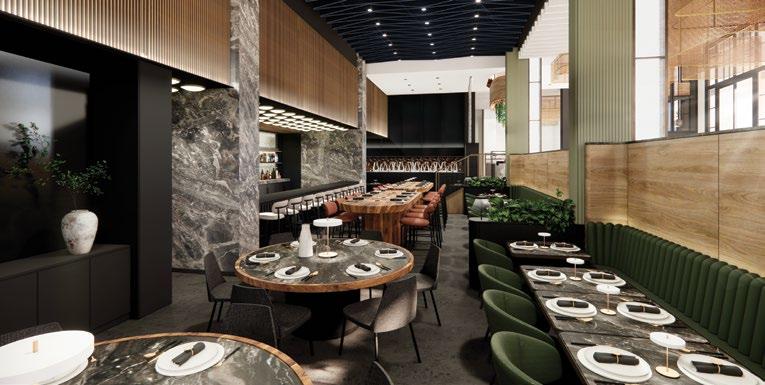
to ski at Mont-Tremblant. Walsh has spent the last 26 years leading the charges at Oliver & Bonacini restaurants across Canada. “Nothing captures the essence of the region more than a festive brasserie, and we look forward to welcoming everyone when we open our doors during the popular ski season.”
Upon entering Le Westin Tremblant, guests will be invited into Léo’s completely transformed space which will anchor a sensational, elevated culinary and social hub for ‘avant’ and ‘après’ moments throughout the four seasons.

Inearly 2024, Le Westin Tremblant will welcome a new upscale destination for all-day dining. Léo boire + manger will be led by corporate executive chef Anthony Walsh from Oliver & Bonacini Hospitality and district executive chef Kevin Ramasawmy from Montreal’s Bar George. Québécois in inspiration with multi-cultural culinary accents throughout, Léo’s menus will change with the seasons and highlight the best ingredients from trusted local producers. Serving breakfast, lunch, and dinner, as well as weekend brunch and late-night cocktails, Léo will deliver a culinary experience that combines excellence with a welcoming atmosphere, catering to both local residents and visiting guests staying at the resort. Focused on delivering top-notch cuisine that is both refined and accessible to all, the restaurant will also showcase a robust
wine list emphasizing natural winemakers and strong local representation with a wide range of varietals and price points.
“We’re honoured and humbled to be involved in this culinary project, especially given its iconic location on Promenade Deslauriers in the centre of the action,” says Walsh, a Montreal native who first learned how
“Exceptional hospitality is achieved by delivering memorable experiences to guests,” said Guillaume Parent, president and managing partner of GPHC Capital, a private-equity firm investing in hospitality and real-estate ventures that acquired Le Westin Tremblant in 2021. “I am thrilled that Léo will harness the essence of Quebec and offer guests an exciting culinary destination to enjoy a superb experience amongst the magic of Tremblant.”
The restaurant’s grand opening is slated for early 2024. FH
SEPTEMBER 2023 FOODSERVICE AND HOSPITALITY 5 FOODSERVICEANDHOSPITALITY.COM MONTHLY NEWS AND UPDATES
FOODSERVICE
ON THE
INDUSTRY
WHAT’S THE SCOOP?
Chipotle Mexican Grill has unveiled Autocado, an avocado-processing robotic prototype that cuts, cores and peels avocados before they are hand mashed to create the restaurant’s famous guacamole. The prototype, developed in collaboration with Vebu, is currently being tested at the Chipotle Cultivate Centre in Irvine, Calif.

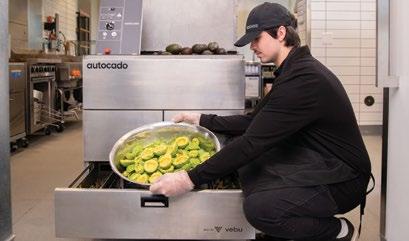
Vebu worked closely with certified training managers from Chipotle’s restaurants to analyze the company’s preparation process and identify tasks that are time consuming and less favourable among crew members. Chipotle currently has individuals dedicated to cutting, coring and scooping avocados. On average, it takes approximately 50 minutes to make a batch of guacamole. However, Vebu’s team is aiming to reduce guacamole preparation time by 50 per cent.
COMMITMENT TO GROWTH
Cardinal Meats Specialists has expanded its head office and main production facility in Brampton, Ont. As Cardinal continues to experience significant growth driven by customer demand, the company decided to expand the facility with an additional 33,000 sq. ft. to the existing 89,000 sq. ft. for a total of 122,000 sq. ft. This additional capacity will allow for new and innovative needs for the company’s expanding customer base.
FLYING HIGH
Osmow’s has opened its first-ever airport location at Toronto Pearson Airport, located in Terminal 1’s domestic sector, post security.
“We’re excited to introduce Osmow’s to Toronto Pearson Airport,” says Khalil Lambert, Chief Commercial Officer, Greater Toronto Airports Authority. “As a leading airport dedicated to providing dining options that reflect the broad diversity of Toronto, we believe Osmow’s will be an outstanding addition that will offer travellers a great Mediterranean and MiddleEastern dining experience.”
LEEDING THE PACK
The Maple Leaf Foods Heritage facility in Hamilton, Ont. has been awarded the Leadership in Energy and Environmental Design (LEED) Silver certification by the Canada Green Building Council. LEED is an international certification recognizing sustainability excellence and green building leadership.

The company received a $2.6 million grant from the City of Hamilton supporting the incorporation of many innovative and environmentally responsible design features which provide environmental and community benefits.
The Heritage facility has implemented several initiatives that have led to gradual reductions in the company’s environmental impact, including a national LED lighting retrofit program, equipment efficiency and optimization upgrades, ammonia heat recovery and wasted heat recovery systems, composting and recycling programs, control measures and closed-loop systems for water use and improvements to storage, handling and employee training to reduce food waste.
As a result, the facility has reduced its electricity intensity by 72.9 per cent, natural gas intensity by 47.2 per cent, water intensity by 54.8 per cent (all from a 2014 baseline), solid waste intensity by 51 per cent (from a 2015 baseline) and food waste intensity by 45.4 per cent (from a 2016 baseline). Key building features that went into creating the green facility include encouraging alternative transportation, such as a bicycle storage area and the use of lowemitting and fuel-efficient vehicles, optimizing energy performance, enhancing refrigeration management, reducing water use, using low-emitting materials and maximizing open space to encourage interaction with the environment, among others.
6 FOODSERVICE AND HOSPITALITY SEPTEMBER 2023 FOODSERVICEANDHOSPITALITY.COM
Let the games begin
a combination of Duolingo and TikTok. The technology incorporates a wide range of interactive game elements such as interactive exercises, points, rewards, competition, quizzes, and achievements.
“Gamification has emerged as a powerful training tool and is essential to creating a more interactive, immersive, and result-driven experience,” explains Klubov.
Data supports the power of gamification in enhancing user engagement, motivation, and knowledge retention. TalentLMS for example reports that 83 per cent of users who receive gamified training feel motivated, while 61 per cent of those who receive non-gamified training feel board and unproductive.
spoon.tech leverages the power of gamification for onboarding and training
Turnover for chain and franchise restaurants has been escalating at an alarming pace, with restaurants reporting anywhere from 65 to more than 100 percent rates. With that comes the added cost of onboarding and training, which are taking a significant bite out of already thin margins.
Retention and engagement are especially challenging with the rise of the Gen-Z workforce whose lives revolve around social media and immersive experiences.
spoon.tech, a new and innovative approach to training and engaging this all-important Gen-Z workforce, is now available to operators in Canada. This single digital tool was built on the premise that the key to change management is digitization – and more specifically gamification of front- and back-of-house processes, from onboarding to health-and-safety training to menu preparation.
Where it began
When Daniil Klubov and Rares Bacila launched their first restaurant venture in 2019 with the goal of building a franchise based on digitization, they quickly realized the magnitude of the management challenges facing operators.
“Even before COVID, turnover was a major problem. After that, it became an enormous one,” says Klubov. “Our research shows that more than 20 per cent of processes in QSR need
revision and retraining, and up to 30 per cent of operators were not fixing issues and essentially working in chaos.”
Adding to the challenge was managing a younger workforce that is more demanding and difficult to engage, he adds. “The industry is competing against social media in gaining their attention. You can’t force them to do what you want. For us the question was, how to make them want to do it?”
The partners decided to develop a technology solution that would deliver onboarding and continuous training processes in an engaging and productive way. Since its launch in March 2023, spoon.tech has gained strong traction with chain and franchise operators throughout Europe.

The gamification factor
Gamification is at the heart of spoon.tech’s user experience, which Klubov describes as
“The increased motivation stems from the inherent fun and excitement that gamification brings to the learning experience,” says Klubov. “Employees are far more likely to invest time and energy into training when it’s an enjoyable activity rather than a mundane obligation.”
How it works
Implementation is a relatively simple process, he explains. “Operators have a lot of knowledge stored on their shared drive: from operation protocols to recipes. We transform these into colorful and playful content under the operator’s guidance and then we launch.”
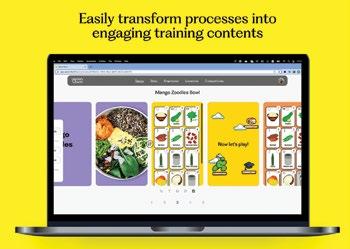
Many of the gaming activities can be digested in “bite-size pieces” in the way of trivia quizzes, puzzle solving, or quick video clips on assembling a signature menu item.
spoon.tech also supports a full range of frontof-house functions, with modules on customer service, safety and security rules, and wine and menu options. “It covers all the processes staff need to know in a continuous learning format,” says Klubov.
Managers can use the spoon.tech portal to monitor employee progress, run competitions, and develop reward programs.
“Digitally enabling employees is the key to the future success of the restaurant industry,” says Klubov. “That’s why we are very excited to bring spoon.tech innovation to operators in Canada.”
If you want to learn more, visit the spoon.tech website, drop the team an email at hello@spoon.tech or register directly for a four-week trial – the team will be delighted to hear from you!

SPONSORED CONTENT
NOW OPEN: KISSA






Toronto’s King West neighbourhood welcomed a new addition to its vibrant hospitality scene with the opening of Kissa, a Japanese-inspired vinyl-only listening lounge. Pronounced “key-sa,” Kissa is derived from “kissaten,” Japanese-style speakeasy teahouses popular in the 1920s, and mixes Japanese-inspired cuisine with an elevated cocktail program.
Designed by Victoria Opacak from All In Design and Damon Snider from Type D Living, the ambiance transports guests to a different time and place, creating a memorable and immersive experience that engages all the senses.

Chef Michael Parubocki (Momofuku, Kasa Moto) is Kissa’s director of Culinary alongside Dylan Sampson (Kiu, Kasa Moto) as head chef. Together, they’ve developed a Japanese-inspired Izakaya-style menu featuring dishes such as shrimp tempura served with a yuzu pepper aioli, wagyu katsu sando and yuzu cheesecake.
Kissa’s Mixology director, Blake Canning (Casa Madera, The Butcher Chef), has crafted an inventive beverage program featuring 18 cocktails named after famous albums, such as “Prince & The Revolution” and “Wildflowers.”
At the end of July, the upstairs open-concept lounge opened with its own DJ booth and bar, along with a private members-only room tucked away for a more intimate experience. The owners of Kissa, Dan Gunam and Vito Tomasicchio, will launch the Goodnight Club, a private members concierge club that will begin at the end of summer, just in time for the Toronto International Film Festival (TIFF). The membership will include VIP access to Kissa and Soluna, in addition to exclusive perks, private parties, international festivals and experiences.
DISASTER RELIEF

DoorDash has expanded its Restaurant Disaster Relief Fund across Canada. With recent devastating wildfires across the country, Canadian restaurants that have been drastically impacted by these and other natural disasters will be eligible to apply for $10,000 individual grants.
Administered in partnership with Global Entrepreneurship Network, the program provides restaurants with grants for a variety of important expenses, including payroll for existing employees, developing new products or services, sourcing or expanding inventory, marketing and advertising and general operating expenses, such as utilities or rent.
There are three application windows over the next year for Canadian restaurants to request financial assistance, including July 5 to Sept. 29, 2023; Oct. 2 to Dec. 31, 2023; and Jan. 2 to Mar. 29, 2024.

Merchant eligibility requirements include experiencing hardship due to a provincially or federally declared natural disaster; operating a brick-and-mortar location; owning three stores or less; employing fewer than 50 employees per location; being open for at least six months; and earning revenues of $3 million or less per location in the last 12 months.


“Restaurants aren’t just places where people get food, they’re pillars of communities across Canada,” says Shilpa Arora, general manager, Canada at DoorDash.
BRANCHING OUT

Fat Bastard Burrito opened its first location outside of Ontario in St. John’s, N.L. on July 21. MBI Brands Inc., the parent company of Mary Brown’s Chicken, acquired the brand last summer. Together, they are now one the largest privately held quick-service-restaurant companies in Canada.

“We’re thrilled to be expanding outside of Ontario and we couldn’t think of a better market to start than the home of Mary Brown’s Chicken. We see this as an essential step toward national expansion and can’t wait to share our menu with the rest of Canada,” says Gregory Roberts, owner of MBI Brands Inc.

R“estaurants seem to be busier than ever.” This is a comment I hear frequently and as a consumer of foodservice meals, I tend to agree. As a foodservice industry analyst, I’m a bit more discerning, so let’s review the data first. Restaurant traffic in Canada for the 12 months ending May 2023 was up by 10 per cent compared to the same period a year ago. This includes a 16- per-cent gain for fullservice restaurants and an eight-per-cent lift for quick-service restaurants. On the surface, these latest results from Circana’s CREST consumer tracking service indicate restaurants are indeed busier. But digging a little deeper, we see restaurant visits have not quite returned to 2019 levels. Additionally, off-premise restaurant occasions now make up an even larger portion of these visits. That means a larger portion of the restaurant traffic is in the drive-thru lane or at the takeout/delivery counter.
But traffic gains don’t tell the entire story. For that, we need to understand how many restaurants there are across the total industry. Circana’s 2023 Canadian ReCount restaurant census shows the net number of restaurants rose slightly in the past year by 0.6 per cent, or 300 units, for a total of almost 62,000 units. This net growth is a bit of positive news against the backdrop of a recent report from Restaurants Canada that indicated restaurant
READING BETWEEN THE LINES
bankruptcies soared to more than 300 in the first half of 2023. Overall, the foodservice industry has lost more than 2,000 net units since 2019. This recent news about closures suggests unit counts will not return to those historic levels any time soon.
The unit-growth trends reveal some of the other challenges and opportunities in today’s restaurant environment. Here’s a quick look:

• QSRs grew by 500 units while FSRs declined by 200. This highlights the incremental hardships faced by FSR operators, despite recent traffic gains.
• The fastest-growing FSR subchannel in terms of unit growth is midscale diners, bucking the trend in overall FSR units. This is consistent with CREST data that shows midscale operators are benefiting from industry morning meal traffic growth of almost 12 per cent.
• Independent and small-chain locations drove most of the unit growth, while large chains with 500 or more locations were flat. CREST confirms this trend as well, as it reports large chains have lost two points of traffic share to these smaller operator sets since 2019.
• Unit growth in the West is outpacing the other regions, matching the region’s traffic-growth performance.
• Restaurant counts outside of the large urban centres grew faster than those within the larger centres. This is consistent with Statistics Canada’s population data, which indicates growth of downtowns slowed during the pandemic. Combined with persistent work-from-home habits and the resulting deficit in work-related foodservice visits, restaurants in the big city cores will continue to face an uphill battle.
So, are restaurants busier than ever? Well, on average, the answer would be yes but it all depends on where the restaurant is located and the customer base it serves. Overall, restaurants aren’t busy enough to return the industry to its former state of profitability. And yet, new restaurants are opening steadily to replace those that have closed; investors and entrepreneurs continue to bank on the industry’s long-term viability. After more than two decades in this business, I can understand that sentiment completely. Canadians love to eat out, and restaurateurs love to serve them. FH
Vince Sgabellone is the director of Client Development and Foodservice Industry analyst at Circana. He can be reached at vince.sgabellone@circana.com


10 FOODSERVICE AND HOSPITALITY SEPTEMBER 2023 FOODSERVICEANDHOSPITALITY.COM
Restaurants seem busier than ever, but the data tells a more detailed story
BY VINCE SGABELLONE
SERVING QUALITY IN FOODSERVICE
We have all heard the analogy of the duck — although calm and collected above the water, its feet are frantically paddling to keep moving and to keep their head above the water. As a smallbusiness entrepreneur supporting the hospitality industry through my two companies, this is how I often feel. And as a hospitality leadership coach, this is what I see with many of my clients on a weekly basis. Let me provide some context. Many of the leaders I interact with and coach are highly successful in so many ways. These leaders have built great companies, operations and teams, but even with all of their success, they can feel a shift in the waters. Revenues might be strong, but profits are tight or declining. Average checks are up, but transactions are down. They have solid teams in place, but turnover is still high. Their online reviews are positive, but deep down they know they are not providing the guest experience they feel they need to as guest/consumer spending
COMMITTING TO CHANGE
Leaders need to create resiliency and momentum
BY MATT ROLFE
gets tighter, and as inflation and interest rates continue to climb.
Let’s take this another layer deeper. I care about businesses and feel that hospitality operations are one of the core elements in an industry that still provides the ability to have human-to-human connection that’s wrapped around a remarkable experience. These experiences are delivered by people who have chosen a path and life of service. We need to acknowledge what we have recently been through, the impact it has had on us and our industry, and be intentional around how we create space to heal. To be successful we need to lead and operate differently for ourselves, and others.
Don’t step over it… lean into it - As high-performing leaders, our job is to be looking six, 12 or 36 months out and to create clarity for our people so they know what is expected of them and how they win in their roles. Not only do we need to keep focused on the future while creating clarity for today, we also need to think about where our leaders, managers, and staff are at, and what they need from us right

SEPTEMBER 2023 FOODSERVICE AND HOSPITALITY 11 FOODSERVICEANDHOSPITALITY.COM LEADERSHIP
ISTOCKPHOTO.COM/DAVIT85
now. You may be feeling positive about where you’re at, but remember your people still need time to process, share, and understand where they’ve been, where the operation is at and where it’s going.
To support them, I encourage you to bring your people together not to talk about operations, goals or targets, but to create space to talk about them — where they’re at, what questions they might have, what things they might have concerns about and what they need from you moving forward. In order to create new opportunities, we need to close the loop on the past. The goal is not to fix, change, or celebrate some of the things that you hear, but to listen deeply and caringly. Once that happens teams can move out of the past and into today, and the future.
Next… relentlessly pursue your desired guest experience –Whether you run a hotel, full-service restaurant, or QSR concept, in order to have a sustainable and scalable operation you must have a great guest experience. If that is the case, then why is service so average in Canada? This year, so many amazing brands have reached out to me to discuss engaging in work together to support their guest experience and employees and there is a recurring pattern in what I’m hearing:
• “During the pandemic we really got great at operations, but we lost sight of our guest experience.”
• “The experience we provide our guest is good, but not good enough.”
• “We have flashes of great service but based on how much turnover we are experiencing; we are not consistent enough.”
My job as a coach is to study what patterns move us towards our goals and what patterns move us away from our goals. Based on guest demands and consumer spending trends, the path to success for your operation is your burning desire and focus to deliver a relentlessly remarkable guest experience no matter what your concept.

I’m not going to get into the framework here of how to design your steps of service, but I want you to focus on the human element of your guest experience. How do you make everyone around you care as passionately as you do about creating a great experience for your guest? I encourage you to spend some time on the three steps below. There are no right answers to these questions, the more focused and intentional you are on your concept, your community, your guest, the
more successful you will be.
Think about your audience – Invest some time into thinking about the questions: “why should your staff care about delivering your guest experience?” Not when they can, not when you’re fully staffed, not when it’s not too busy… why should they provide this experience every time? What’s in it for them? Is it working on a team that deeply cares about the work they are doing? Is it because of the financial upside they will experience based on tipping culture? Is it because they will feel recognized, supported and valued on a daily basis by your managers and guests? Make it cool to care and execution becomes much easier.

What you measure improves – Online reviews are great, but I encourage you to think about additional ways to measure your guest experience. When you measure consistently, it forces the leaders to clearly explain their expectations to their managers and staff. This might sound simple, but I often walk into a new client and ask if I can go to a few staff members and have them write down the experience they are expected to create for their guest. Around 95 per cent of the time, the staff provide fundamentally different answers. If you measure the behaviour consistently it allows for you to do the following.
Recognize and reward – One of my favourite books of the last few years is Atomic Habits by James Clear. He proves through his research that you can only sustainably change behaviours through recognition of progress in the direction of your goals. Create clarity, measure consistently, and then recognize and reward regularly and you will provide your staff and guest a desirable experience in your establishment.
Times are challenging, but if you lean in, commit to positive, productive, and outcome-focused change, your people and operation will succeed moving forward. FH
For more FREE tools and resources to support this change, email Matt Rolfe at matt@mattrolfe.com

12 FOODSERVICE AND HOSPITALITY SEPTEMBER 2023 FOODSERVICEANDHOSPITALITY.COM
ISTOCKPHOTO.COM/ANDREYPOPOV [SMILING RESTAURANT STAFF]
SPREADING YOUR WINGS
HOW TO DETERMINE WHETHER YOU SHOULD FRANCHISE YOUR RESTAURANT BUSINESS
BY LAUREN PARKER AND ALLAN D.J. DICK
FRANCHISING presents a powerful opportunity for restaurant owners to expand on the success of their brand and accelerate growth. In deciding whether to franchise, restaurant-concept owners should carefully consider several crucial factors.
1. Do you have a proven concept?
Franchising should never be the first step in your restaurant venture. Putting your concept into practice, testing its viability, assessing its replicability, and ensuring its profitability are crucial first steps.
You should consider the following (note that this list of considerations is by no means exhaustive, but aims to
demonstrate the types of considerations needed to assess your readiness to franchise):
• Profitability and cash flow: Prior to franchising, you will need to evaluate the financial performance of your initial unit or units and ascertain the concept’s ability to generate sufficient cash flow. Model profitability forecasts for both your existing unit(s) and the expected functioning of franchisees, considering their operational differences, additional fees (i.e. franchisees will pay fees to the franchisor that the original restaurants have not), and differences in funding sources and debt obligations.
SEPTEMBER 2023 FOODSERVICE AND HOSPITALITY 13 FOODSERVICEANDHOSPITALITY.COM FRANCHISING
ISTOCKPHOTO.COM/INVINCIBLE_BULLDOG
• Registered trademark: A strong and protected brand is vital for a successful restaurant-franchise system. As such, you should ensure you have registered trademarks, or have applied for trademarks that you have been advised are very likely to be registrable, associated with your concept to increase the value and attractiveness of the franchise opportunity.
• Learnability and replicability: Potential restaurant franchisees want to buy into a business that offers greater ease and chances of success compared to starting from scratch. As such, before beginning to franchise, you will need to ensure all aspects of your concept — including marketing strategies, proprietary methods, standards, and operational procedures — are thoroughly tested, documented, and effective and that you have created a replicable “system” that can be easily learned and applied by others in various locations and markets.
• Unique value proposition: Assess whether your concept offers distinct characteristics and operates within a market that provides substantial returns and sufficient barriers to entry. If your concept can be set up without assistance, does not require the use of any unique or proprietary methods or features, and is relatively inexpensive to operate, then potential franchisees may not perceive any value in joining your system over simply replicating your concept independently.
2. Do you understand the roles and requirements of a franchisor?
Franchising your business requires a significant investment of time and effort. In determining whether you are ready to become a franchisor (and whether you want to), consider the following:
• Leaving daily operations behind: As a franchisor, you must step away from day-to-day operations and focus on managing and supporting a network of franchisees. This includes creating and delivering comprehensive training programs, providing ongoing guidance, monitoring performance, and addressing any issues that may arise, all while having an eye on keeping your concept fresh and relevant.
• Head-office infrastructure: You will need to establish a capable head-office infrastructure to provide administrative, operational, and support functions. This may include hiring teams to be responsible for franchise development, training, menu development, marketing, operations, legal compliance, and ongoing support.
• Capitalization requirements: You will need to have adequate capitalization to fund the franchise-development process,
including market research, lead generation, recruitment, and evaluation of potential franchisees. Capital is also needed to cover expenses related to franchise sales efforts, attending trade shows and industry events, and advertising the franchise opportunity to attract qualified candidates.
3. Do you understand how to maximize growth in the franchise model?
Within the franchise model, a franchisor can grow and expand their business by employing various strategies and initiatives not available outside of the franchise model. In franchising your concept, you will need to learn how to select the best options for you and the growth of your system. Some considerations include:
• Revenue silos: Within the franchise model, a franchisor can drive growth and expansion by utilizing revenue silos strategically. Revenue silos refer to various income streams that contribute to the financial stability and growth of the franchise system. Examples of common revenue silos utilized in restaurant franchise systems include: franchise fees, royalty fees, marketing fees, build-out fees, product or service sales, technology fees, product rebates, transfer fees, training and support service fees, and ancillary income (income generated outside franchise operations, e.g. through private label supermarket or online sales). Franchisors must maintain a balance between revenue generation and ensuring the profitability and success of their franchisees. Strong financial health allows franchisors to invest in ongoing support, marketing initiatives, research and development, and other growth-focused activities that drive the long-term success of the franchise system.
• Understanding the sales process and choosing the right franchisees: The sales process for franchises involves a series of steps designed to attract and evaluate potential franchisees. Provide them with information about the franchise opportunity, and ultimately close the sale. You will need to determine how to best generate leads through marketing efforts, evaluate potential franchisees, and close the sale. Choosing the right franchisees is crucial for the success and growth of your franchise system. In determining your sales strategies and plans, you will need to ensure that you establish clear criteria for selecting franchisees, including financial capability, relevant experience, and alignment with your brand values.
• Adaptability and continuous improvement: Franchisors must remain agile and innovative to stay ahead of market trends and consumer demands and ensure the continued growth of their system. One source of new ideas and suggestions for improvement is the franchisees themselves. Franchisors should encourage franchisees to share ideas and suggestions for
14 FOODSERVICE AND HOSPITALITY SEPTEMBER 2023 FOODSERVICEANDHOSPITALITY.COM
improvement and leverage their collective insights to drive innovation across the franchise network.
• 4. Franchising with Knowledge and Compliance
Once you have a proven concept, and are ready to move forward with franchising, the actual process can begin. At this point, you should ensure that you retain the necessary and appropriate professional advisors to guide you through that process and ensure that you understand the various requirements and your rights and obligations.
• The regulatory regime and the law: Franchising involves legal and regulatory complexities that must be carefully navigated and which contain serious repercussions if done wrong. As such, prior to franchising your concept, you should be sure to retain counsel that is experienced in franchise law to ensure compliance with local, provincial, national, and international laws.
• Preparing franchise documentation: Prior to franchising your concept, you will need to ensure that all of the necessary documentation is in place. This includes a franchise disclosure document (depending on where you will be franchising) and a franchise agreement and numerous additional agreements that form part of the relationship. Franchise documentation should be prepared by your counsel, with significant input from you.
The preparation of franchise documentation encompasses various business decisions that are crucial for establishing a successful system. For example, you will need to make decisions with regard to:
• Franchise Fees and Payments: You must determine what fees will be payable by your franchisees and in what amounts. Your franchisees must be able to sustain these payments while also being able to service their financing costs, make a living, and realize a return on their investment.
• Term and Renewal: You need to provide a long enough term and renewal term(s) for your franchisees to be able to make a return on their initial investment.
• Premises and Land Control: You need to decide who will hold the leases. This involves determining both the amount of potential liability you are willing to take on, and how much control you want to have over your franchisees’ premises.


• Territory and Market Exclusivity: You will need to determine what kind and what size of geographic territory or market, if any, franchisees will have the exclusive right to operate in and how third-party delivery system will work for your concept.
• Brand Usage and Social Media: You will need to define the
parameters for using your brand name, trademarks, logos, and intellectual property. You should be sure to consider social media’s role within your franchisees’ businesses. Social-media platforms offer significant marketing potential, brand promotion, customer engagement, and reputation management. Control over social media varies, and establishing guidelines and strategies is vital to ensure consistent brand messaging and reputation protection.
Franchising can be a powerful strategy for the expansion of a successful concept, but it requires careful consideration and preparation. By assessing the viability of your concept, embracing the responsibilities of a franchisor, and understanding the franchising process, you can make an informed decision and set the stage for a successful franchise system. FH
At Sotos LLP, we have been designing successful restaurant franchise systems for more than 40 years. If you are contemplating franchising or wish to discuss your current system, please contact Lauren Parker at lparker@sotos.ca or Allan Dick at adjdick@sotos.ca
SEPTEMBER 2023 FOODSERVICE AND HOSPITALITY 15 FOODSERVICEANDHOSPITALITY.COM
ISTOCKPHOTO.COM/INVINCIBLE_BULLDOG
PAST &







































































































PRESENT FOOD FILE
Traditional tastes and innovative new flavours battle for menu supremacy
BY DENISE DEVEAU
or decades, pizza and pasta menu options have stood the test of time. Their long-lasting popularity speaks to the fact they can easily be adapted to appeal to all audiences, from the traditional to the adventurous, from the budget conscious to the upscale diner.
As both categories continue to hold their own, there is a noticeable move to diverging trends. For some consumers, it’s a throwback to traditional dishes. “Bolognese is always going to be a best seller no matter what, the same way the Margherita is for pizzas,” says chef Alessandro Vianello at Vianello Hospitality in Vancouver.


On the flip side, other chefs are getting creative with ethnic food trends, such as Korean-style pizza with bulgogi or fried chicken, he says. “I still think operators are leaning to the traditional Neapolitan-style pizza for example. But quite a few are doing Chicago deep dish, Detroit, and NewYork style.”
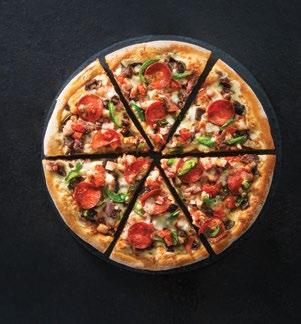
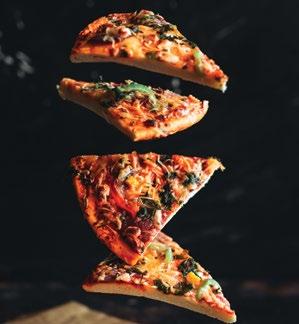
The push for plant-based, gluten-free and non-dairy options is stronger than ever. “There has been a shift to health since COVID,” says Stacey Patterson, owner of Il Fornello. “Plant-based menu items now account for a good portion of sales. Gluten-free is huge, as well as alternative grains and whole-wheat pastas.”
Dairy-free and vegan are also taking a prominent places on both pasta and pizza menus. “Some of the best-selling pizzas are
SEPTEMBER 2023 FOODSERVICE AND HOSPITALITY 17 FOODSERVICEANDHOSPITALITY.COM
ISTOCKPHOTO.COM/ANTON OSTAPENKO [THE CHEF SPRINKLES PIZZA];
Double or nothing
Purists have long touted the benefits of double-zero (or 00) flour. Much like champagne, the designation however, only speaks to where it is milled, explains Reid McEachren, associate marketing manager for Ardent Mills in Mississauga, Ont. “To be called double-zero, it must be Italian milled. The wheat is not the special part. It is related to the steps taken in milling. The same quality of hard wheat is grown and milled [the same way] in Canada.”

“Traditional double-zero is pretty expensive,” says Steven Silvestro, chief consultant, The Fifteen Group. “But you can get the same quality from Canadian red hard wheat and make delicious pizzas [and pastas]. It is stretching beyond what Italians told us was possible.”
vegetarian. It’s the same with pasta,” says Vianello.

THE PIZZA LEGACY
Pizza showed its staying power during and post-COVID, outperforming most other quick-service restaurant (QSR) offerings. Despite the fact the market is seeing an influx of new and innovative global flavours and cuisines (Middle Eastern, Asian, Greek, et cetera), “Pizza remains one of the legacy products, along with burgers and chicken,” says Vince Sgabellone, foodservice industry analyst with Circana in Toronto.
QSRs saw healthy growth over the past year, although not quite as much as other channels, he notes. “That is only because pizza sales didn’t decline as much during the pandemic so they didn’t have as far to bounce back. Overall, QSR is as popular as it has ever been and accounts
Il Fornelo's orecchiette funghi
18 FOODSERVICE AND HOSPITALITY SEPTEMBER 2023 FOODSERVICEANDHOSPITALITY.COM
MAKE YOUR OWN LUCK





With Old California® we leave nothing to chance. We work hard to produce some of the finest quality, fresh-packed California tomato products for restaurants around the world today. We know you take your customers’ satisfaction seriously, and so do we.






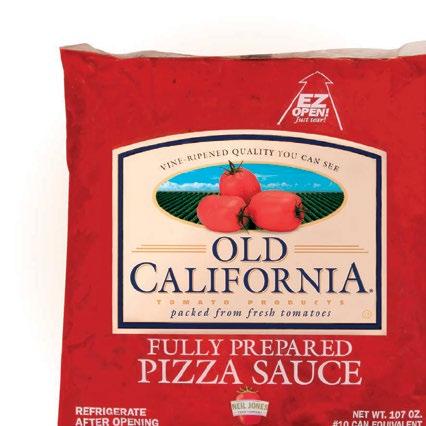


Real quality takes intention, planning and execution. When you get it right, it’s like the stars have aligned just for you.
So the next time you’re looking for a certain something to set your menu apart, let us know. With a good luck charm like Old California®, there’s just no telling where you’ll go. njfc o. com






for 70 per cent of all pizza served in the market. The last year also saw growth for independents, which is taking some share away from chains.”

The main challenge for any legacy platform moving forward is keeping products new and exciting, he says. “People want something that is fresh and different. Operators need to figure out a way to continue to make their product relevant within the changing face of the Canadian restaurant consumers. The youngest cohort is the most ethnically diverse ever so there’s a whole different consumer base there.”
This is where independents are at an advantage over large chains, as they have the flexibility to make changes quickly, says Sgabellone. “It’s harder to make changes at the big-chain level.”
“There is a lot more customization as consumers look for unique experiences,” says Robert Carter, managing partner with the StratonHunter Group in Toronto “Menu items and selections are becoming much more flexible.”
People are looking for boutique options, confirms ChefD of ChefD TV and owner of ChefD Pizza in Kitchener, Ont. “People want to see blue cheeses, pulled pork, aged cheddar, full-fat mozzarella, and bocconcini. They are doing a lot more with oregano, citrus, garum masala, and curries.”
One area that is seeing a lot of activity is Asianstyle noodles, says Steven Silvestro, chief consultant, The Fifteen Group. “Ramen is humongous. Restaurants are really stepping up the game and having great success.”

“We’re seeing a lot more Asian flavours being brought into menus for chefs to play with,” says Kirk Borchardt, senior R&D chef for Ardent Mills, in Saskatoon, Sask. “Pan-fried and stir-fried menu items are really resonating with people and delivering a good rate of return for chefs.”
“Pan fried and stirfried noodles on menus have increased 13 per cent in foodservice,” reports Reid McEachren, associate marketing manager for Ardent Mills in Mississauga, Ont.
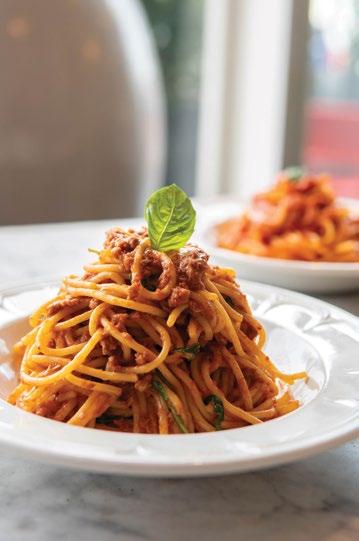

20 FOODSERVICE AND HOSPITALITY SEPTEMBER 2023
FOODSERVICEANDHOSPITALITY.COM
WE BRING PIZZA TO LIFE
From essential pizza staples to authentic ingredients, Sysco delivers everything you need to rise above the rest. We take pride in sourcing the nest ingredients for Canadian restaurants.
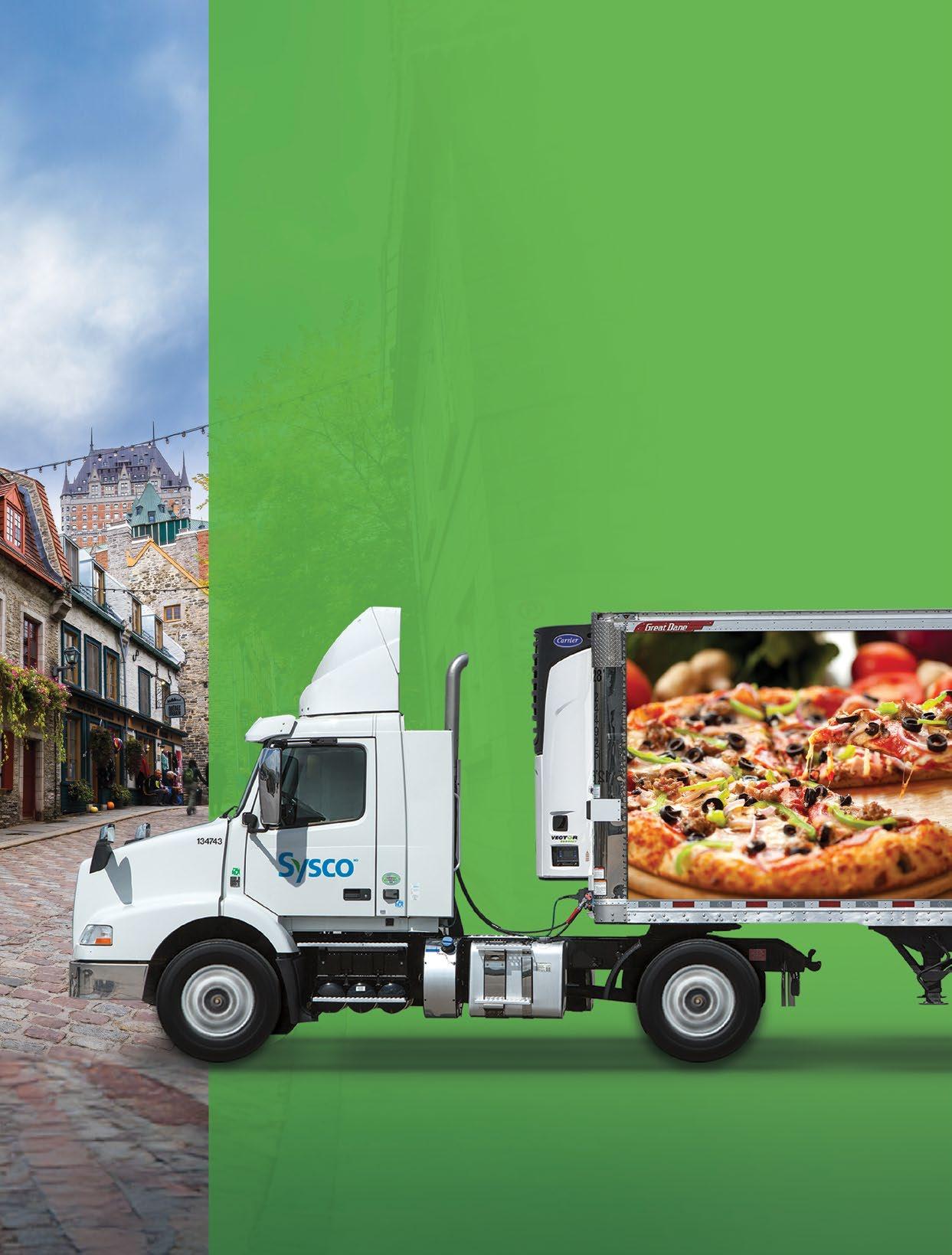
With unparalleled product assortment, trusted industry expertise and innovative solutions, we are ready when you are.










Learn More at sysco.ca



COVID also pushed more operators into the retail sector, says Sgabellone. “The QSR segment was very nimble during the pandemic with subscription and frozen ship-to-anywhere models. Retail fresh-made pizza now accounts for three per cent of the market, and it’s growing.”

PASTA KEEPING TO ITS ROOTS
Pasta continues to do well as a mainstay menu item, but the trend seems to be reverting to simplicity over experimentation. “People are going to the classics. They’re not really delving into the crazy toppings,” says Vianello.

Authenticity in ingredients and preparation is a sought-after quality, he adds. “There’s a purity in the approach to pasta.
Chefs are focusing on the very simple Roman classics such as carbonara, cacio e pepe, and amatriciana using highquality ingredients.”
Patterson says she is seeing a preference for more classic Italian pasta dishes. “Spaghetti and meatballs
and lasagna are making a comeback. We’re not seeing the rich cream sauces now.”
For ChefD, it’s macaroni and cheese that’s in high demand for catering events. “We’re doing a lot of that lately.”
Whereas there was a time when fresh pasta was considered to be the only quality option, chefs are learning that certain dishes can be much better with dried pastas, says Vianello. “We’re now seeing a mix of menus using dried as well as fresh pastas and focusing on different sauces and seasonality.” The choice very much depends on the type of dish, says Steven Silvestro, chief consultant, The Fifteen Group. “Pappardelle with Bolognese or boar ragout needs to be made with fresh pasta. A spaghettini dish with pomodoro sauce
22 FOODSERVICE AND HOSPITALITY SEPTEMBER 2023
FOODSERVICEANDHOSPITALITY.COM
There’s a purity in the approach to pasta. Chefs are focusing on the very simple Roman classics such as carbonara, cacio e pepe, and amatriciana using high-quality ingredients
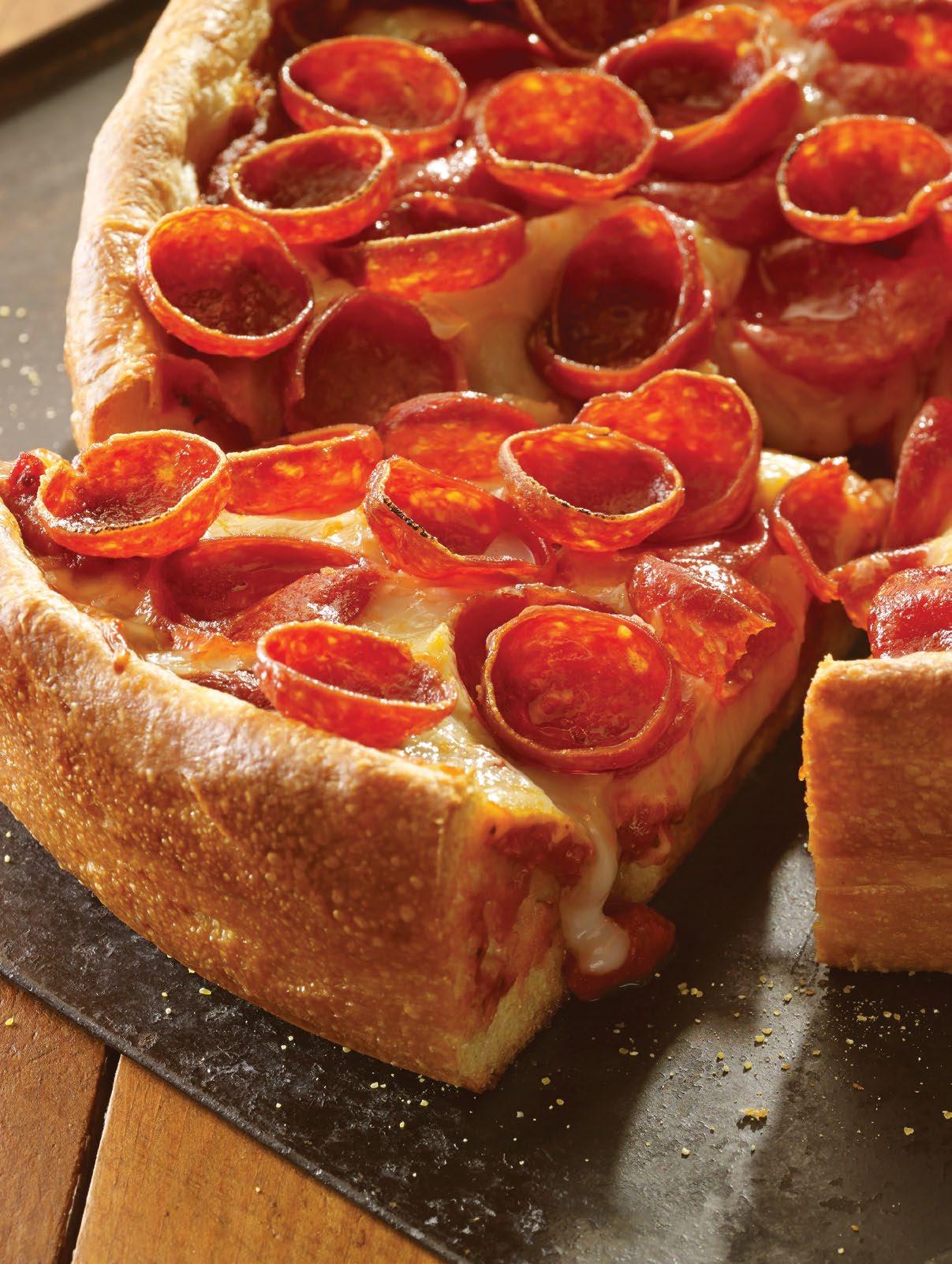














TOP YOUR PIES. PACK YOUR TABLES. With picture-perfect curls and charred, crunchy edges, every slice with ROSA GRANDE™ Cup and Char Pepperoni turns ordinary guests into long-time fanatics. ©2023 Hormel Foods Corporation Try it yourself at hormelinternationalfoodservice.com
is best when using dry spaghetti that is cooked to order.”

Sometimes the choice simply comes down to cost and how authentic you want to be, says Silvestro. “Dry is less expensive and easier to execute. One bonus is that you can blanche it ahead of time, while you have to keep fresh pasta in a freezer and cook it to order.”
THE FLOUR DEBATE
Whether talking pizza or pasta, flour is at the heart of every culinary discussion. While traditional flours continue to dominate, there has been noticeable movement towards alternative flour options in recent years.
“There are a lot of traditional flours, but also demand for innovation in the way of quinoa and chickpea-flour pastas,” says Reid, associate marketing manager for Ardent Mills in Mississauga, Ont. “Ancient
grains bring authenticity into the pizza and pasta market as consumers are more focused on nutrition.”

“Quinoa is showing huge gains in popularity as it has good high-quality protein and is sustainable,” says Borchardt.
“It’s not just vegans and vegetarians looking for those things. A lot of non-vegans are doing Meatless Mondays and looking to expand their protein base.”
Ardent Mills studies show that 80 per cent of consumers prefer function over taste, while 54 per cent credit chickpea with high nutritional value, says McEachren. “Gluten free has now surpassed thin crust pizza in menu mentions in Canada.”
A PROUD HERITAGE
Whatever competitive forces are at work, pizza and pasta are two culinary traditions that have been able to weather any storm. From takeout and cafeteria style to family friendly and fine dining establishments, pizza and pasta provide endless opportunities for operators to adapt to the times. FH



FOLLOW US ON INSTAGRAM Covering everything from chef profiles to the latest food and beverage trends in Canada’s foodservice and hospitality industry @FOODSERVICEMAG












BRING TO THE TABLE THE RICH TASTE OF ITALIAN TRADITIONS For more information about Barilla, please contact our broker: National ASM Waypoint contactus@asmwaypoint.com 1 (888) - 551 - 5777 Quebec Accord Food broker info@accordcourtier.com 450 - 419 - 8666 © BarillaCanada 2023 DID YOU KNOW? Pasta is 90% of the plate but only 10% of total Food Cost. With Barilla, high-quality, al dente pasta will be your new profit generator. ITALY’S N˚1 BRAND OF PASTA TM






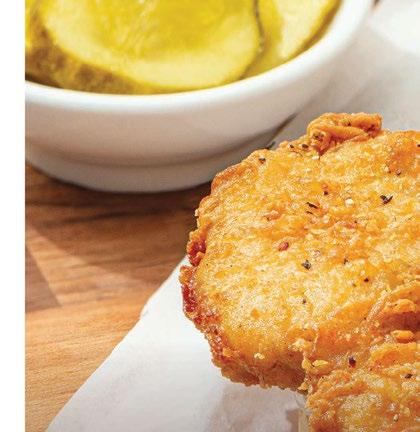



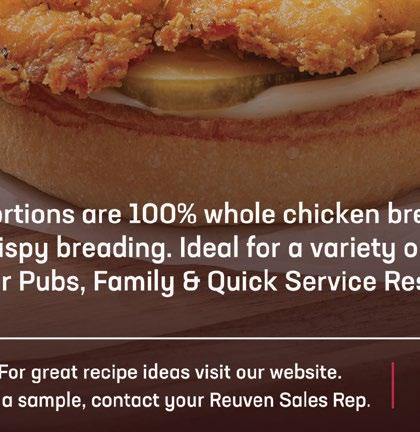

THE CHALLENGE
Labour issues and the restaurant industry have been uncomfortable bedfellows since time immemorial, the relationship became particularly strained during the pandemic, when so many restaurant staffers left the bedroom altogether, amid shutdowns and unsteady-looking futures. And those with their eyes on the scene will tell you the situation was dire before COVID and hasn’t improved dramatically since it receded. That’s because, when the dust settled and restaurants looked to re-build their rosters, there was no one to be found. Indeed, says Bruce McAdams, associate professor, School of Hospitality, Food, and Tourism Management at the University of Guelph, the labour crisis plaguing the restaurant industry today is nothing short of “existential.”

There’s never been a shortage of challenges that the industry hasn’t been able to “duct-tape its way through,” he says. This time, he’s not so confident about an industry that’s been slammed for its long hours, low wages, and unsavoury working conditions.
The first thing McAdams asks
A shift in thinking is needed to address the labour crisis
BY LAURA PRATT
students in his “Introduction to Foodservice Management” course is what it’s like working in the restaurant industry. They respond with harrowing descriptions of stressful, long hours, arduous work and holiday shifts. More
than that is what those in the academic space term “emotional labour” — or “having to deal with cranky customers and how those people weigh on your mental health and well-being.”
“That’s a huge problem to
overcome. Addressing this reality calls for stakeholders coming together to destigmatize foodservice work.”
This is new territory for the restaurant industry, he says, recalling his early forays into it and how the expectation, then, was to simply “suck it up.” More recently, he wrote a paper on mental health and all 20 of his interview subjects said they spend “a significant amount of time” handling their employees’ well-being and mental health.”
Additionally, a recent study done in New Zealand showed what Gen Zs dislike the most is having to work with people. “It’s almost the perfect storm against the industry right now.”
And the scene is exacerbated by a demographic tidal shift that’s seen the pool go shallow and the bathers take shelter.
There are 1.1 million people in Canadian foodservice, and some 50 per cent of Canadians have worked in the industry. But Canada has a shrinking pool of 15-to-19-year-olds, with 20-to-24-year-olds basically flat. These sectors account for almost half the foodservice workforce. Additionally, young people are delaying work in favour of education and volunteerism.
Before COVID, job vacancies in Canadian foodservice hovered
SEPTEMBER 2023 FOODSERVICE AND HOSPITALITY 27 FOODSERVICEANDHOSPITALITY.COM
CHALLENGES & OPPORTUNITIES
around 65,000. Thanks to the pandemic and the widespread fear it engendered around shutdowns, the summers of 2021 and 2022 saw approximately 162,000 foodservice vacancies; today, there are 98,000. The situation is particularly dire in rural areas, says Chris Elliott, chief economist and VP of research, Restaurants Canada.
What happened to restaurants during the pandemic is well known. The foodservice industry was regularly in the mainstream media talking about having to introduce furloughs and pivot to takeout. Restaurants generally became more chaotic as a result — the government declaring starts and stops, owners bowing under debt loads, people leaving in droves and every workday short on staff, with those in attendance scrambling. In no time, it became all about survival.
McAdams resists pointing figures for the current crisis. “I’m not an economist,” he says, “but from a micro point of view, the greatest single issue holding restaurants back right now is the lack of quality management in their operations, the lack of leaders.”
That’s the case, he suggests, because managers switched industries during the pandemic “because they were furloughed or it was a gong show.” A continuous labour shortage followed, with a dearth of people to cover shifts, requiring management to step in — not a sustainable model.
It’s not surprising, McAdams says, that hospitality schools suffered declining enrolment among domestic students during and post COVID. A Canadian Tourism Human Resource Council study asked respondents if they would recommend a job in hospitality to their family. Pre-pandemic, 60 per cent said yes; after the pandemic, just 40 per cent did. McAdams has his 40 fourth-year hospitality students in his leadership course write weekly reflections on their hospitality placements. “What I read is sometimes horrifying, often sad.” Their stories about the work environments, sense of satisfaction, and opportunities for growth and development, are disheartening, he says. Half the people in his four-year program don’t intend to stay in the industry after they graduate. “It’s a heartbreaking place we’ve created.”
With the exception of some champions trying to improve things, he says, there’s not a collaborative approach from industry stakeholders to addressing the labour shortage.
As someone whose first job in restaurants was in 1979 when he was 14, he says the scene is a far cry from what it was. “As an industry, we’re almost in intensive care.”
More than that, he says, the labour crisis and the disengaged workers it’s produced have reduced the quality of restaurant’s products. “Labour,” he intones, “impacts everything.”
Another issue McAdams singles out invokes the supply side. There are “far too many restaurants in this country, if you actually want to get to the nuts and bolts of the labour issue,” he says. He blames this on low barriers to entry and a franchise system whose overseers are haphazard with their franchise sales, placing restaurants in locations with no chance of success, keenly aware that their top-line royalties are not dependent upon profits.
THE OPPORTUNITY
Still, McAdams is not without hope. “It always gets worse before it gets better,” he says. Ultimately, he believes restaurants are resilient. While restaurant workers don’t save lives, per se, he says, the pandemic revealed that they do improve life. He says stakeholders need to regard the labour issue with so-called “cathedral thinking,” a concept drawn from the Middle Ages, when people worked on projects they wouldn’t live to see finished. “That’s what we need to understand, that this isn’t going to be fixed in five years.”
And in the meantime, he believes working environments have improved, thanks to the removal of some of the mental-health stigma and the eradication of some of the kitchenbased harassment. “In my day, if a chef threw a plate at my head, I’d duck. Now, if you throw a plate, you’ll be cancelled.”
As for the enduring problem of emotional labour, wherein guests feel more entitled, more willing to raise their voice, companies
are not putting up with it. “They’re firing customers, putting policies on menus and front doors saying this is a safe work environment, you must respect our staff. That sort of line has been drawn in many places as we try to restore the balance of power with our customers.”
Another meaningful legacy of the pandemic, says David Hopkins, president of The Fifteen Group, is that it forced restaurants to figure out where they made their money, and respond accordingly, with some closing for all but their dinner rushes and others shuttering in the early days of the week.
Beyond that, says Hopkins, “we’re paying our staff better to retain them, which needed to happen.” Inflation and COVID have prompted restaurants to raise their prices and, he says, those that did this wisely could pay their employees more as a result, and give them better standards of living, which bumped retention. “That’s a great thing.”
Indeed, says Elliott. The pandemic fallout is “forcing operators to examine the culture in the workforce, and be more mindful of how valuable staff are to the success of the business. As Warren Erhart of Whitespot Restaurants has said, ‘It’s not about the great resignation now, it’s about the great retention.’”
Individual restaurants can beat the labour challenge with progressive policies and strong, peoplecentric leadership, McAdams says. “The best operators I know are fully staffed now and continuing to raise the bar. They’re paying for [employees’] work shoes, offering benefits, saying if that’s what it’s going to take to have them stay with me, so be it. I can’t operate my business without it.”
The trick, he believes, is for restaurateurs to break out of a woe-is-me mindset, where they’re glued to labour statistics, gloomy Restaurants Canada statements about shortages and Bank of Canada predictions of recessions, and instead start viewing individuals as assets. “They need to say, ‘I must convert this 17-yearold who seems to be enjoying their summer work in my restaurant to thinking about this as a career opportunity.’”
In other words, restaurants need to focus the same attention on the experience of their internal customer as they do on that of their external customer. “That takes a cosmic shift in energy,” McAdams says. “And that’s how we can get through this.” FH
28 FOODSERVICE AND HOSPITALITY SEPTEMBER 2023 FOODSERVICEANDHOSPITALITY.COM
It’s not about the great resignation now, it’s about the great retention
Operators struggle to find balance when it comes to third-party delivery
 BY LAURA PRATT
BY LAURA PRATT
The Challenge
When Restaurants Canada asked its members in a recent survey whether they wished they had fewer seats in their restaurants, a startling 25 per cent said yes (with about 43 per cent of operators with 200 or more seats to fill expressing this wish for fewer seats). This, says Chris Elliott, Restaurants Canada’s chief economist and VP of Research, suggests that, as on-premise dining has not fully returned post pandemic, off-premise foodservice, such as labour shortages, will persist. More than that, it indicates that these
operators know they’re not getting enough people in their restaurants and are anxious to do something about it.
It’s a reflection, he says, of their understanding that, while we’re closer to pre-pandemic restaurant traffic, we have yet to reach it. People have simply gotten too used to pandemic habits, such as picking up food on the way home, eschewing out-of-office lunch breaks and post-work confabs, and generally eating at home more often.
“The industry is re-balancing,” Elliott says. “We may be ordering as much food in terms of sales dollars, but it’s
SEPTEMBER 2023 FOODSERVICE AND HOSPITALITY 29 FOODSERVICEANDHOSPITALITY.COM
CHALLENGES & OPPORTUNITIES
shifted a lot beneath the surface, and that’s putting financial pressure on operators.”
Enter food-delivery systems, the powerful not-so-new player on the foodservice landscape that is either a boon or a threat to restaurants, depending on where you sit.
Full-service restaurant patronage is still 30 per cent above what it was prior to the pandemic, says Restaurants Canada data, while on-premise dining remains about 10 per cent below. Achieving a balanced existence in the company of foodservice-delivery systems is an incontrovertible reality, Elliott says, but operators shouldn’t demur in their efforts to attract customers to their dining-rooms, where frills such as alcohol and appetizers promise boosted sales compared to those that might take place virtually.
George Wensley, the long-time proprietor of Leslie Jones, an eclectic 90-seat neighbourhood restaurant that opened in 2006 and closed in 2023 in Toronto’s Leslieville neighbourhood, says it was the physical inconvenience of having to fold these food-delivery operations into his own that turned him off the concept. “Someone would place an order with Uber Eats and I would say it’ll be 20 minutes and there’d be someone standing at my bar five minutes later. We were a small, intimate restaurant, and having this guy there waiting for his order, crowded in against our regulars, gave off a bad vibe.”
In fact, Wensley resisted signing on with these systems for a long while, finally capitulating in the face of a high-pressure sales push in 2018. But from the start, he was not a fan. In addition to the physical inconvenience of their presence in his tight space, he resented the huge nightly bite they took from his sales — equating it to one employee’s wages. Combined, he says, these factors so turned him off the idea that he bailed on his one contract soon into signing it. “You’re talking about profit margins and the potential of maybe injuring your regular dinner service and having regulars who may not return because of having to wait for
their food and having to deal with all these takeout containers. It was not worth whatever potential extra money I may have made.”
The Opportunity
Individual restaurateurs’ take on the thirdparty delivery concept notwithstanding, fooddelivery systems are here to stay, says Vince Sgabellone, a foodservice industry analyst with Toronto-based Circana. “The consumer is demanding them, and it’s up to the restaurateur to decide if they’re right for their business, but the trend is seeing more people eat restaurant foods outside of restaurants.”
These aggregators have tremendous potential to help restaurants in their quiet times. Case in point is Domino’s recent partnership with Uber Eats in the U.S. One of
the largest delivery brands teaming up with a third-party aggregator extends impressive credibility to the thirdparty aggregator, cementing its place in the foodservice space.

The Fifteen Group’s David Hopkins’ says food-delivery systems aren’t a bad development for many restaurants. “If you’ve got excess capacity and you’re not busy-busy, go for it. While the contribution margins to your profits are lower than if someone came into your restaurant, you’re still making money off it. In my mind, it is a good thing.”
Total on-premises volumes dropped from 42 per cent share of the foodservice market in 2019 to about 35 per cent today. It’s creeping up slightly, Sgabellone says, “but offpremises remains elevated and it’s going to stay there. My message to the industry is pick your lane, stay in it, and execute in it better than anyone else. If you want to be the best eat-in restaurant and don’t want to bother with off premises, good, just do it better than anyone else. Or if you want to close your dining-room and just do delivery, great, but do it better than anyone else.”
“We’ve come to accept that the foodservice-delivery systems are the reality,” says Elliott. “But no one should give up encouraging people to visit restaurants.” He cites perks such as trivia nights, wine and beer tasting, and other initiatives to draw would-be customers away from their Netflix couches and remind them why they want to be at restaurants. “I feel like operators are paying attention to that and that there’s innovation on that front.”
When the pandemic hit, Wensley briefly considered revisiting food-delivery systems, but ultimately steered clear and instead introduced his own delivery service — free for orders over $200. “That was great, and I didn’t have to give any of it away.”
Similarly, new organizations will manage a website and app for their own brand, reducing restaurant commission and sidestepping pricey third-party delivery platforms. This fringe idea that is growing quickly also allows restaurants to enact promotions that sweeten the deal for the customer, such as discounts for ordering directly from their website. FH
30 FOODSERVICE AND HOSPITALITY SEPTEMBER 2023 FOODSERVICEANDHOSPITALITY.COM
We’ve come to accept that foodservicedelivery systems are the reality
GETTING GHOSTED
Ghost kitchens offer new opportunities for brick-and-mortar operators
BY LAURA PRATT
The Challenge
Let’s say you’re a restaurant that’s sometimes packed and sometimes not. And let’s say you’ve abandoned your off-premises services, rejecting takeout and delivery as you simply can’t handle the extra capacity along with your busy dinner service. Now you find yourself watching your walls during lots of dayparts and wondering where everyone is. Then you hear about the concept of ghost kitchens.
“The market has changed and people are demanding more off premises,” says Vince Sgabellone, a foodservice industry analyst with Circana in Toronto, which, he says, explains the rise of this relatively new

incarnation on the restaurant scene that’s as nebulous as the name suggests.
“There’s no precise definition for a ghost or virtual kitchen,” Sgabellone explains. “They’re all slight twists on the theme.” In any event, they’re scenarios in which an existing restaurant extends some of its space and resources to another operation — either an outsider looking for a place from which to prepare and sell its wares, or a new enterprise of the original restaurant owner, launched on the back of its existing assets. There are other models under the ghost umbrella too, like that of Kitchen Hub, a large facility in which many restaurants operate. But in every case, these are brands that do business out of the back of
a house and exist solely in the delivery-takeout space.
The idea that this new channel of food distribution asks more of the pie, which took such a hit during the pandemic anyway, could give some restaurateurs pause. After all, the wing slingers and sandwich purveyors and vegan outfits that sprang up inside this trend draw from the same limited public purse the rest of the restaurant industry already has hands in.
The Opportunity
But instead of panicking, you might, at this juncture, ditch fretting over how the market will accommodate these newcomers
SEPTEMBER 2023 FOODSERVICE AND HOSPITALITY 31 FOODSERVICEANDHOSPITALITY.COM CHALLENGES & OPPORTUNITIES
for inviting them under your roof and start exploring how you might exploit your assets into a realm of promise and growth. Here’s where the ghost kitchen concept comes into its own.
Ghost kitchens, in every iteration, exploded during the pandemic, with at-home dwellers revelling in the enhanced options available to them for dinner. While they’ve softened somewhat in the meantime, they’re still growing concerns given their foundation in delivery, which is still at twice the level it was before COVID.
As murky as the ghost-kitchen concept is, it solves the problem of idle space in a time of high expenses and unexploited resources. And it allows entrepreneurs the opportunity to test-drive concepts without having to make expensive commitments in leases and staff.
In the Venn diagram of the current foodservice scene, the intersection of offpremises, third-party aggregators, and ghost kitchens is a pretty big one. “Virtual kitchens springboarding off existing restaurant operations is something that could be interesting,” says David Hopkins, president of restaurant consulting company The Fifteen Group. “It can work very well. If I’ve got a restaurant that’s not very busy and my kitchen staff aren’t rammed, I can either lay on my own virtual brand or lay on [someone else’s] and get some extra revenue coming in on my traditional brand.”
“With restaurants being locked down for 400 days, we had no choice but to order delivery,” says Sgabellone. “And, similarly, the restaurateurs had no choice but to figure out how to do delivery. Consumers are still eating out and taking delivery. There are no signs of it going down because, quite simply, we’ve gotten used to it.”
Delivery — across the board, including third-party operations, traditional telephone orders, and ghost kitchens — accounts for about six per cent (or half a billion) of all restaurant occasions. It’s small, Sgabellone concedes, but it’s doubled what it was three years ago. On-premise business, meanwhile, represents three billion visits a year, down
from about four billion before the pandemic — a decline that’s larger than the entirety of the delivery business
“To suggest that ghost kitchens are hurting on-premise business is not the case,” says Sgabellone. “It’s carryout that’s persisting. What the dine-in restaurants — quick- and full-service — need to consider is that off-premise is going to continue at higher than historic levels and there’s no expectation that it’ll go back. So, it’s up to the restaurant to figure that out.”

Ghost kitchens, still figuring out their own business model, are here to stay, agrees Hopkins. An excellent example of the concept can be found in the U.S. chain Chili’s, that opened a chicken-wing brand in the summer of 2020. Soon after its launch, Just Wings was bringing in an extra US$3 million a week to Chili’s and had expanded the restaurant by close to 1,000 locations at a time when everyone was ordering delivery anyway.
Indeed, says Sgabellone, the rise of virtual kitchens is not only not a threat to traditional dine in, but an opportunity, given the power these offshoots have to increase a brand’s footprint and to try out new concepts without requiring a huge overhead or the construction of an entirely new physical restaurant.
“It’s an opportunity we didn’t have 20 years ago. In every seminar we do, we say revenue is the most important thing for restaurant success. Revenue reigns supreme. If you can layer on more revenue without having to layer on more staff, well, that’s fantastic,” says Sgabellone. FH
32 FOODSERVICE AND HOSPITALITY SEPTEMBER 2023 FOODSERVICEANDHOSPITALITY.COM
Virtual kitchens springboarding off existing restaurant operations is something that could be interesting
Universal Design
took on in 2019 when it elected to transform a formidable former industrial railway building into a waterfront destination for Spud Islanders and P.E.I. visitors —
Universal design (UD) is an approach to the creation of products and environments

regardless of their needs. In the context of restaurants, the application of UD principles includes spatial considerations
navigability for people using a
FOODSERVICE AND HOSPITALITY 33 CHALLENGES & OPPORTUNITIES
FOODSERVICEANDHOSPITALITY.COM
Making restaurants accessible to all is key to
wheelchair or other mobility aids.
According to the Center for Universal Design, UD is “the design of products and environments to be usable by all people, to the greatest extent possible, without the need for adaptation or specialized design.”
Any UD product or environment needs to be accessible, usable, and inclusive. The seven principles of UD are: equitable use, flexibility in use, simple and intuitive, perceptible information, tolerance for error, low physical effort, size and space for approach and use.
The Canadian Charter of Rights and Freedoms guarantees the right to the equal protection and equal benefit of the law without discrimination and, in particular, discrimination on the basis of disability. And the Canadian Human Rights Act recognizes that all individuals should have an opportunity equal with other individuals to make for themselves the lives that they are able and wish to have and to have their needs accommodated without discrimination and, in particular, discrimination on the basis of disability.
Building on these pieces of legislation, Parliament adopted the Accessible Canada Act (ACA) in 2019 “to ensure a barrier-free Canada,” by January 1, 2040. This involves identifying, removing, and preventing barriers in federal jurisdiction in such priority areas as “the built environment.”
Beyond these acts, disability regulations are largely determined at a provincial/territorial level, and while they share certain elements, they also have distinctions.
In British Columbia, for example, accessibility is an important part of the BC Building Code, which sets the rules
for the design and construction of new buildings; accessibility code requirements help ensure buildings are designed and constructed so everyone can reasonably approach, enter, and exit them; and move safely throughout them to use the facilities and services.
In Nova Scotia, the updated Nova Scotia Building Code requires any new restaurants be accessible to everyone, with food-safety permit granting dependent upon their having accessible entrances, pathways and washrooms.
In Manitoba, meanwhile, the Accessibility for Manitobans Act calls for “barrier-free access to goods and services” and requires that any aspect of organization’s “built environment intended to facilitate barrier-free access to the goods or services it provides [be] available for use in the intended manner.”
In Saskatchewan, the Saskatchewan Accessibility Act, enacted in 2021 after a long period of anticipation during which many complaints were lodged about people’s physical, attitudinal, and systemic challenges when trying to access public spaces, promises a barrier-free province, including in the built environment.
In Alberta, restaurants must be accessible to people who use wheelchairs, though the Alberta Safety Codes Act’s requirement of a barrier-free design of new buildings and premises excludes many older businesses, which remain less accessible for people with physical disabilities.
And in Ontario, where 2.6 million people have a disability and more than 40 per cent of the population is over 65, the customerservice standard under the Accessibility for Ontarians with Disabilities Act outlines requirements for service providers to make their facilities accessible for customers with disabilities. The first province, and one of the world’s first jurisdictions to enact specific legislation establishing a goal and time-frame for accessibility, Ontario’s the first jurisdiction to establish standards in the design of public spaces. This province has pledged full accessibility by 2025.
THE OPPORTUNITY
Founders’ Hall, the two-level European-style food hall that is the jewel of the Charlottetown waterfront, is more than 100 years old. It measures 16,000 sq. ft., and has a capacity
for 500 people. Here, visitors can choose from among the offerings of 18 local vendors, including owner-operated purveyors of paninis, vegan comfort dishes, Turkish street food, French Caribbean cuisine, and the island’s only sushi burrito. And for those among their ranks whose dining-out requirements include those acknowledging physical limitations, a range of measures is in place.
Because Founders’, which resides on the Port of Charlottetown’s properties, services a regular torrent of patrons who flow from the cruiseships that dock in its harbour, the operation is extraordinarily accommodating to the range of ability levels these passengers — many elderly and infirm — possess. “We say Founders’ is for everyone,” says Jennifer Blair, Founders’ Marketing and Event manager. “And we do our best to make sure there are no physical or prestige barriers so everyone can enjoy themselves here.”
The proof begins outside the building, where a boardwalk leads from waterfront to retail space. It was important for designers to make the dining hall’s exterior features flat and even, along with all its parking lots, curbs, and ramps. A rope runs along the boardwalk, strung between the posts, to assist people who need something to hold onto to guide their uncertain steps toward the warehouse-style space.
Wheelchair-accessible automated doors allow visitors to gain access to the building with the push of a button. Inside, the main floor sports a wide hallway that designers ensured left adequate space for an unobstructed flow of traffic — wheelchair users and walkers alike — and to accommodate the comfort and ease of movement of everyone. The flooring is smooth and even. The open mezzanine level is large and airy with high ceilings and big windows. The seating, opposite the food vendors, is food-hall, cafeteria-style. All the tables are wheelchair accessible and patrons can move them around to accommodate walkers and wheelchairs and make room for passage as needed. The tables are at a height that allows for the wheelchair user to sit comfortably and to move the chairs around to accommodate different groups. Hallways to the washroom are wide, as are the cubicles themselves. Sinks are at an appropriate height.
Different legislation exists across Canada when it comes to accessibility, so operators need to do their research in order to ensure that their restaurants are meeting the standards that will allow them to be enjoyed by all. FH
34 FOODSERVICE AND HOSPITALITY SEPTEMBER 2023 FOODSERVICEANDHOSPITALITY.COM
When quality is key
Functionality is essential in the foodservice industry, and our team is ready to work with you on customized solutions for your menus. When it comes to serving your cheese needs, we deliver.


Here for you


agropursolutions.ca




Free Business Membership. No Minimum Order Required. Shop where the chefs shop To find a location near you, visit wholesaleclub.ca Follow us @therealcanadianwholesaleclub Save time, shop online.† Place your Wholesale Club order online and pick up in-store. †Applicable fees for in store pickup of online orders are extra. In-store pickup of online orders is only available at select locations and on orders over $75. Why Shop at the Club? • No Membership Fee. • No Minimum Order. • Restaurant Quality Products. • Product sold by the each, Club Pack, case or pallet. • Wholesale pricing and savings through our Multi-unit discounts on thousands of items. ✓ ✓ ✓ ✓ ✓ • Fast check out and efficient store layout to minimize your time away from your business. • Extended opening hours for your convenience. • Commitment to food safety. • Great value on our Sunspun brands, no name and many other private label products. • Focus on your business and leave the shopping to us with PC Express. ✓ ✓ ✓ ✓ ✓
FALL BAKING with WHOLESALE CLUB
Get

Available at your local Visit www.wholesaleclub.ca to check out our full assortment of baking products.
ready to elevate your fall baking game with Wholesale Club! Our premium baking ingredients and supplies
capture the essence of the season.
us today and let the baking begin!
are here to
Visit
CHANGING THE
RECOGNIZING THE ROI OF MENTAL-HEALTH SUPPORT FOR RESTAURANT EMPLOYEES IS KEY TO DRIVING CHANGE
BY AMY BOSTOCK
WHEN HASSEL AVILES first started openly sharing her story about her mentalhealth challenges, depression and anxiety in 2018, she started normalizing these conversations for herself. “And then I started going on panels, doing it publicly in front of strangers and engaging the industry with these conversations.”
At the time, she recalls, there was a lot of resistance. “There still is a lot of resistance today, but there was even more back then because this was not a normalized conversation,” says Aviles, co-founder and executive director of Toronto-based Not 9
to 5, a non-profit global leader in mentalhealth training and advocacy for the foodservice-and-hospitality sector. She adds that a lot of people wanted to talk about mental health at the time, but not in public. “There’s still a lot of stigmas, and a big part of the work we were doing back then was around creating awareness.”
And then, in June 2018, celebrity chef Anthony Bourdain took his own life. “A big shift started — one of the first big shifts I saw — because it became so apparent that mental-health challenges can happen to anyone and everyone,” says Aviles. “It
doesn’t discriminate based on who you are, or how much money you have, or if you’re a television star.”
In 2020, Not 9 to 5 created a mental health and addiction survey for the hospitality industry and the results told an alarming story. When asked, “Do you live with mental health and/or addiction challenges?” 90 per cent of hospitality workers answered yes.
In fact, the food-and-beverage service industry ranks in the top-three worst workplaces for mental health, as stated by Mental Health America (2017), due to a combination of toxic work environments and
MENTAL HEALTH
38 FOODSERVICE AND HOSPITALITY SEPTEMBER 2023 FOODSERVICEANDHOSPITALITY.COM
THE NARRATIVE
a lack of available support and resources from the top down (Cheang, 2017). According to the Mental Health Commission of Canada, substance use, socio-economic insecurity and unemployment are high-risk factors for suicide and suicidal behaviour; factors that are endemic to the foodservice industry (Mental Health Commission of Canada, 2020).
“From the perspective of people that are experiencing [mental-health challenges], there’s still a lot of shame and on the employer side, a lot of them are unequipped for the jobs that they have in terms of managing people,” says Aviles, adding there’s antiquated systems in place that keep people silent and oppressed — systems that are normalized — such as the brigade system in kitchens. “And it’s not just kitchens anymore; the brigade system has seeped out of kitchens into every aspect of the industry. And it normalizes a hierarchical organizational structure that is based on fear and authority. And while initially, in the late
19th century when this first started, it was meant to be in the name of efficiency, in actuality, it’s dehumanizing.”
She says a byproduct of this culture is that people are told that their emotional experiences have to be repressed and suppressed. “And there’s also a culture of mistakes being penalized and inducing shame around mistakes versus seeing mistakes as part of a natural human learning process.”
MONEY TALKS
According to Deloitte Canada, the negative impact poor workplace mental health has on Canada’s economy is staggering. The company’s first-of-its-kind Canadian research, released pre-pandemic, found that positive returns on investment (ROI) of workplace mental-health initiatives are within reach for Canadian businesses and revealed that companies with mental-health programs in place for one year had a median annual ROI of $1.62 for every
dollar invested. For companies with programs in place for three or more years, the median annual ROI is more than double — valued at $2.18 for every dollar spent.
The report, The ROI in workplace mental health programs: Good for people, good for business, explores historical investment and savings data from seven large Canadian companies at various stages of rolling out mental-health programs and supports.
“There’s both an economic and moral imperative for Canadian employers to take action, recognizing that the cost to the Canadian economy of poor mental health in our workplaces is estimated to be $50 billion annually,” says Anthony Viel, Chief Executive Officer, Deloitte Canada in the report. “The findings from this report provide a business case that is impossible to ignore. Organizations committed to delivering and measuring impactful employee wellness programs are creating healthier workplaces
MENTAL HEALTH
SEPTEMBER 2023 FOODSERVICE AND HOSPITALITY 39 FOODSERVICEANDHOSPITALITY.COM
and seeing investments in their people’s mental health pay off.”
In Canada, although foodservice remains one of the top employers, the industry has huge challenges filling vacancies. Restaurants Canada reports the industry is lagging behind other sectors when it comes to job recovery. In June 2022, there were 171,715 job vacancies, a threefold increase from pre-pandemic levels. The industry’s exceptionally high employee turnover rate is important because finding, hiring, and training new employees costs a great deal of money. In addition to the expenses involved in onboarding new workers, high staff turnover can also have a negative impact on employee morale, productivity, and customer experience.
Kris Hall, founder of U.K.-based The Burnt Chef Project — a global not-for-profit founded in 2019 that provides hospitality professionals in 120 countries with mental health and leadership training and education, support services, data collection and fundraising activities — agrees there’s a strong business case for offering mental-health support to foodservice employees. “We’re actually starting to make sure that people are feeling like there’s work-life balance, that they have the right culture and that they’ve been well looked after physically and mentally, because they’ll perform better for you, and they’ll stay in your organization longer,” he says, adding “we complain that customers won’t pay more for their meal, when food costs have risen. We’re making maybe two-per-cent margin. But if we’re not looking after the people, turnover rates are 125 per cent on average, which costs employers between $2,500 and $4,000 per person as a result of them walking out the door.”
Aviles points out that every time an employer invests in someone with workplace mental-health training or education, there’s a return on that money. “And obviously, the more you invest in for a longer period of time, the higher the return. I don’t think our industry knows this; I think our industry is still stuck and thinking of this as a ‘nice thing to do.’ It’s not about nice, it’s not about being kind and this isn’t about empathy or compassion. I mean, obviously, that comes with it, hopefully, for people, but that’s not the only reason. There’s a huge return on investment, it decreases employee turnover, it increases innovation, retention and creativity within the workplace and psychological safety. There’s just so many benefits to investing
in workplace mental health, education and training/programming. There is a massive business case and I don’t think our industry is aware. We have a lot of conversations around the problems, but we don’t have a lot of conversations about the solutions.”
CHANGING HIS TUNE
For Brendan Piunno, who had his first restaurant job at age 14, the hospitality industry is all he’s ever known. But after more than 20 years of working in restaurants, his career began to take a serious toll on his mental health.
“We started losing people for good and not just from quitting. I worked with a manager that passed away from drugs and alcohol and that became a very common story over time. It got to the point where, for me, I couldn’t see that anymore,” says Piunno, who is now partner, and COO of Piano Piano in Toronto.
He began to see that the first step to solving any problem is realizing there is one. “There’s a huge need for mental-health support in this industry. It’s a very fast-paced, hectic, hard industry to be in.”
In fact, a Statistics Canada study found that hospitality workers have the worst job quality out of any industry, due largely to low earnings, the inability to take time off, no paid sick leave, a lack of training opportunities and no supplemental medical and dental care.
Piunno feels that not a lot of people outside of the restaurant industry completely understand that. “So, it was time to start making a move to support the people that
work for us [at Piano Piano]. I don’t think anybody goes into hospitality unless they have a passion or a love for it. But everybody needs to also love themselves first before they can start loving the industry they’re in.”
He’s a huge advocate for “finding that person you can talk to, to kind of lighten the burden, and to be able to go into work and not have that carried around with you. I know personally, that when I go into work now, I’m a different person than what I was before I started therapy. And I’m forever thankful for the people that that pushed me into seeking that help. Because it’s scary to get started.”
When it comes to showing the business case for mental-health training and support in the industry, he says “the hard part for us is it’s almost like the ‘you can lead a horse to water but can’t make it drink’ kind of scenario. We have all of these programs in place, but we can’t make anybody use them, even though we know that everybody would be would benefit from them.”
The other challenge operators face, he says, is that offering mental-health support in the workplace has to be an all-in commitment from the top down to break down the stigma.

Piunno stresses that seeking help for your mental health does not mean you’re failing. “I used to think that way, too. I thought I wasn’t strong enough and I saw it as a failure, and that mindset is what has to stop.”
At Piano Piano, management has invested heavily in caring for its employees’ mental health, rolling out support programs through Inkblot, a Toronto-based EAP
40 FOODSERVICE AND HOSPITALITY SEPTEMBER 2023 FOODSERVICEANDHOSPITALITY.COM
Psychological Safety: the ability to be oneself without fear in a workplace. This includes being seen as dramatic, incompetent, negative, or disruptive. For this to happen, everyone on the team needs to feel confident that no one will embarrass or punish them for admitting a mistake, sharing an emotional experience, asking a question, or offering a new idea.
Source: A Guidebook: Improving Workplace Mental Health in Hospitality, Not 9 to 5
(employee assistance program) offering personalized, accessible and confidential mental health and well-being support for individuals and organizations.
“The next thing we’re looking at is an optin scenario. Just because the benefits are there doesn’t mean you’re going to use it, so we’re allowing people to opt into some of these programs. Financially, it’s a big impact on the restaurant — the restaurant industry has razorthin margins — but we’re trying to offer this to as many people as we can because we believe that there is a huge return on people’s mental health when they access this type of support.”
As the industry starts to support people’s mental health, Piunno believes employees will be more likely to stay in the industry.

“From what we’ve seen at Piano Piano, and I can only speak to that, the more you can give to an employee, the more programs you can have in place for the people that want to opt into them, the lower the turnover. We have a very, very low turnover rate at Piano Piano and that’s something we’re very proud of. And I believe it’s because of the support that we give.”
STAR POWER
With the recent arrival of the Michelin Guide in Canada (Toronto and Vancouver), many people have been critical of the process of achieving Michelin stars, calling the system antiquated.
Hall says while Michelin is a great driver for people wanting to achieve great things in the industry, at The Burnt Chef Project, he’s working on creating an accreditation system based on psychological safety and backed in scientific data.
“At some stage in the next five years, we want to be able go to Michelin with [a ranking] that actually rewards businesses for sustainable practices. And people that have it should be the new gold standard, because it shows that people aren’t being harmed to achieve it.”
He adds that it shouldn’t be a separate recognition, but built into the overall criteria. “If you’re going to get a star at all, it’s not just front-of-house service, food, wine and decor; let’s spend a day or two in the back of house and with the actual teams in the trenches and see how it’s being run. Let’s look at the books and see how these people are getting paid? Are they getting a living wage? And what is the morale and the culture like behind the scenes? Customers should be having that
insight into what actually happens at these restaurants and what it takes to offer that level of service. And I feel Michelin Guide has that exposure, that reach, and they should be tackling it head on if they are really that interested in making sure our industry is the best industry. So, I think it’s nice to have an award system. Michelin’s well respected and it does drive people to perform and to achieve great things, but it needs a refresh.”
THE PATH TO CHANGE
Chef Imrun Texeira, owner/chef of Wanderlust Dining, a luxury culinary brand, grew up in a “more old school era of restaurant culture and now, being on the other side of it, I was in this weird middle ground of seeing the old school [practices] while being part of the new-school generation coming in. And it’s hard for me now to make that transition, getting out of what I thought was so normal. I see restaurants gaining acclaim around the world, but how these restaurants run behind the scenes is obviously not sustainable. It’s amazing to get recognition for what we do in front of the guests in the dining rooms, but if, behind the scenes it’s all dirty and chaos, it’s success at what cost?”
Texeira, who advocates for better working conditions and mental-health support for those in hospitality as the Canadian Ambassador for The Burnt Chef Project, says the current reality is that in order to work in hospitality and to receive recognition and acclaim, you have to sacrifice your life and your health. “And it shouldn’t be a sacrifice. This is a professional choice, right? It’s a fantastic industry, and we love it dearly. But why should people have to end up with diabetes or heart disease or depression, suicide in order to be able to pursue that career? You wouldn’t expect that in any other sector.”
The foodservice industry is not unique with regard to mental illness challenges, but Texeira says it’s seen as more of a badge of honour to be burning out but still coming to work. “But the real badge of honour should be that your restaurant has a great retention rate, happy staff, a good culture. I take a week off at a time and
I’m okay with that. That should be the new normal. But there’s a generational thing with the old-school mentality of ‘well, we were caught up, punched and kicked and burnt and brutalized, but it’s better now, so stop complaining.’ But that mentality needs to move on and either get with the times, adjust, or have to wait patiently until you leave. And then we’ll be able to really start to change”
HELPING HANDS
Normalizing mental health is the first step to making this change and creating a healthy workplace, says Debbie Garshon, Clinical Lead at Inkblot. “It’s creating a culture of awareness and openness around mental health. Because in order to break the stigma, you need to be open, accepting and acknowledging that it’s normal for people to sometimes have really bad days.”
She explains that restaurant employees are under a great deal of pressure due to the fastpaced nature of the job, which contributes to mental-health challenges. “A lot of employees are afraid to come forward and let [employers] know they’re having mental-health challenges, and they might fear being judged. So, speak to the team, make them aware of the importance of mental well being, of taking care of yourself. Perhaps offer mental-health days and let them know we’re all going to be there for each other, so it’s okay to call in sick.”
She says education is key to helping identify others who are struggling. “It might be someone like an EAP company coming in to train the staff. If you demonstrate the value of mental health, in the workplace to your team, they’re going to feel more comfortable about either speaking up around it, or taking care of their own mental health, because they will understand that they need to do that.” FH
SEPTEMBER 2023 FOODSERVICE AND HOSPITALITY 41 FOODSERVICEANDHOSPITALITY.COM
Student-centric research tackles how to identify food waste and what to do about it
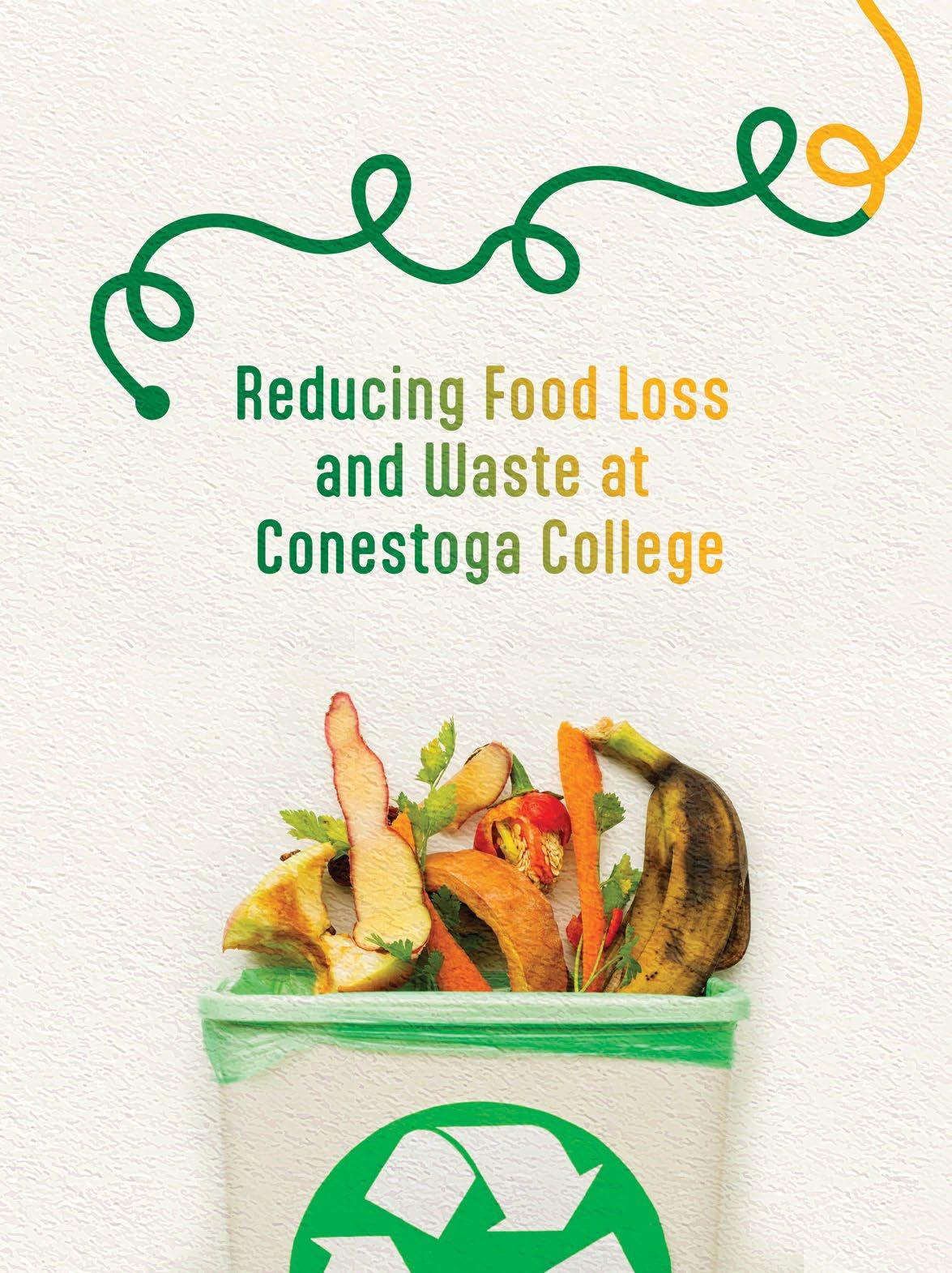 BY NICOLE DETLOR
BY NICOLE DETLOR
42 FOODSERVICE AND HOSPITALITY SEPTEMBER 2023 FOODSERVICEANDHOSPITALITY.COM SUSTAINABILITY
SUSTAINABILITY has come to be defined by the three Es in today’s global economy — Economy, Environment & Equity. At Conestoga College’s School of Hospitality & Culinary Arts, a team of researchers, faculty, and students is transforming the student-run Bloom restaurant into a climate-action living lab. The Living Lab team is working to demonstrate the impact and solutions to greenhouse emissions related to food packaging and food waste. Why is reducing food waste important? A significant amount of food grown for human consumption is not consumed. According to the 2019 research paper, The Avoidable Crisis of Food Waste, nearly 60 per cent of food produced in Canada, totalling approximately 35.5 million tons, is wasted annually. What’s worse, 32 per cent, or 11.2 million tons of that food (worth a staggering $49 billion) is perfectly edible and could be re-directed. The economic, environmental, and equity (social) imperatives cannot be overemphasized.
Economic

Food wasted and lost during harvesting, processing, storing, and transporting adds to the cost of food. Reducing food waste throughout the supply chain is important and earlier is better to reduce incurring additional energy inputs. For example, the circularity method involves re-imagining endof-life waste for potential alternate uses. An example of this is the use of orange pulp to make fiber ingredients for binding water.
Environmental
When food is wasted, all the inputs including the land, water, feed, fertilizer, fuel, and other inputs are also wasted. To add to this, a major externality to consider is the 57 million tons of greenhouse gases (GHG) that are released into our atmosphere. Especially concerning is that upon decomposition in the landfill, organic waste produces methane gas, which is 25 times more damaging to the environment than carbon dioxide alone (Waste Reduction Week in Canada, 2022).
Equity (Social)
The number of people using foodbanks in Canada continues to increase and is at an all-time high. One in every three individuals using a food bank is a child (despite representing only 20 per cent of the population). Across Canada, people access food banks 1.4 million times each month (Food Banks Canada, 2022). Worldwide, nearly 1 billion people are malnourished. Food waste reduces the availability of food to those who need it.
Where and how is our food wasted?
Food waste due to restaurants and hotels represents 13 per cent of food waste in the supply chain. Studies have found the major categories of food waste for restaurants include food preparation waste (45 per cent), inedible food waste (21 per cent), and food left uneaten by customers (34 per cent) (Lightspeed, 2021).

SEPTEMBER 2023 FOODSERVICE AND HOSPITALITY 43 FOODSERVICEANDHOSPITALITY.COM
PHOTOS PROVIDED BY CONESTOGA COLLEGE
Sustainability at Conestoga

Laura Matheson, a professor in the Sustainability Business Management Program, and Carrie Herzog, a professor in the Global Hospitality program at Conestoga College, worked with staff at the Bloom restaurant to provide fact-based data to make decisions on how waste could be reduced at the restaurant.

food waste was found in three different streams, 3.1 kg was from the diningroom/plate waste and 57.2 kg from the kitchen compost bins. In the garbage stream intended for landfill, 4.9 kg of organics was found, showing a high rate of compliance with composting, and still room to improve. A follow-up waste audit focused on plate waste from the patrons of the restaurant. This involved separating out the type of waste returning uneaten on customer plates and separating it into meaningful streams to provide feedback to the chefs.
Reduction of Food Waste

The restaurant waste can be separated into two large categories: back of house and dining-room/plate waste. Back-of-house waste is food waste from preparation or food that’s spoiled or past expiry date. Plate waste is mainly uneaten foods from the consumer but can include dropped plates or food sent back to the kitchen. This research project focuses on practical, low-cost solutions to reduce food waste.
Under the guidance of Professors Matheson and Herzog, students planned and conducted food-waste audits to identify the sources of waste and to set a baseline to monitor progress. The result of the audit provides a benchmark that will guide further follow-up studies and decision-making.
The results of the audit found that of the 86.3 kg of waste collected during a 24-hour period, food waste made up 75 per cent (65 kg). The












Although some food waste is unavoidable in the preparation of food, having a plan can enable re-directing as much as possible. The team at the Living Lab zeroed in on the hierarchy of waste reduction: prevent, reduce, re-use, recycle/ upcycle, recover, and compost. As with any change, regular training is crucial to success, and staff need to understand the different waste streams and their correct usage. As well, accessibility to dispose of waste accurately is critical. By re-considering how some bins were lined and access in areas where need was highest, compliance increased.
The avoidance of spoiled ingredients and prepared food as a waste stream is dependent on a robust inventory-management system tied to an ability to forecast sales. The implementation of techniques such as




44 FOODSERVICE AND HOSPITALITY SEPTEMBER 2023 FOODSERVICEANDHOSPITALITY.COM
Manufacturing Consumers Processing Restaurants & Hotels Retail Stores Production 6% Distribution 5% 23%
20% 13% 12%
21%
01 03 02 05 04
2 Identify the root causes of food loss and waste
3 Selection and evaluation of solutions STEP 4 Implementation of solutions
5 Monitor results
1 Identify food loss and waste (conduct a food audit) PHOTOS PROVIDED BY CONESTOGA COLLEGE
Source: The Avoidable Crisis of Food Waste, Value Chain Management International, 2019
STEP
STEP
STEP
STEP
FIFO (first-in, first-out), DOH (days on hand), colour-coding and multi-use ingredients all assist with managing. FIFO is an inventory-management system that organizes ingredients in a way that they are rotated to ensure that oldest ingredients are used first. DOH provides data to those ordering ingredients to calculate the average number of days that inventory is held before use. This can help with future decision making regarding ordering, ensuring that the days on hand are kept for as short a time as possible.
Colour coding makes for quick decision making when selecting ingredients from storage and helps the person ordering ingredients. Another approach is to include date received and use-by-date labelling on all ingredients and prepared foods. An ingredient with a single use may be more difficult to manage in inventory as its turnover rate will depend more heavily on the accuracy of sales forecasting. Multi-use ingredients offer some flexibility in the menu and ensure that ingredients can be used within their shelf life.
Having a plan for prepared food that will not make it to the consumer before reaching the end of its usable shelf life can also help reduce waste. Several apps have been developed that help to connect customers with restaurants (and other food services) to ensure excess prepared food does not go to waste. Also, having a plan to donate food while it is still useable is another
WASTEREDUCTION STRATEGY






way to prevent food from going to a waste stream. Food banks are a great partner and having prior relationship and plan for donation help to make this type of arrangement easier to execute. Upcycling edible streams may include using vegetable trimmings for soup, stocks, or sauces.
The waste generated in the dining room impacts the consumer experience more than the other categories discussed, therefore implementation with this lens is important. A waste audit helps identify menu items that are prone to end up in the waste stream (or that are not taken away by consumers). Adjustment of portion sizes to reflect consumption is one way to address this source of food waste (BehmanMilicevic, A. (2022)). Ongoing review of the impact to the consumer experience is important when adjustments are made to the menu to ensure the desired results are achieved.
Results of the waste audit at Bloom restaurant found that plate waste was mainly side-dish carbohydrates such as potatoes or a bun. Offering consumers these items as an option may reduce this plate waste, for example asking if the table wanted a bread basket rather than automatically bringing one to the table. Another area of food waste observed from the dining room was cream and milk from coffee-and-tea service. By asking customers their preference and only bringing what they will consume, it’s possible to reduce the amount wasted. As some plate waste will still occur, providing staff with easy access to compost bins helps to ensure this stream is disposed of correctly.
There will always be opportunities to reduce food waste. Having fact-based data to support strategies to reduce food waste along with plans for reduction is critical. By making small incremental changes, we can all have an impact to reduce our food waste. FH
FOODSERVICEANDHOSPITALITY.COM
Nicole Detlor is the director, Food Research
PREVENT FIFO, DOH, colour coding, multiple use ingredients REDUCE Reduce plate servings (carbohydrates) RECYCLE/ UPCYCLE Use peelings etc. for soups RECOVER
of apps or donations COMPOST Readily available compost bins
Use
46 FOODSERVICE AND HOSPITALITY SEPTEMBER 2023 FOODSERVICEANDHOSPITALITY.COM SLUG HERE SEPTEMBER 2023 EQUIPMENT
HEARTH
PLATE From to W
hen it comes to pizza equipment, chefs have an endless menu of options, from wood and gas-burning to propane-fired and conveyor ovens; from countertop and mobile to standalone units. As the demand for pizza remains strong, chefs are discovering creative ways to showcase their talents while meeting the needs of their audiences, whether for takeout, dine-in, or outdoor catering.
Here’s a look at a few of the many ways chefs have equipped their operations to meet customer demand.
BURNING IT UP IN THE GREAT OUTDOORS
Since COVID, outdoor dining has become a popular attraction for consumers. That’s why Chris Haworth, owner of West Avenue Cider House in Freelton, Ont., recently decided to build a customized outdoor woodburning pizza oven for its orchard property’s growing foodservice operations.
Equipment options abound for today’s pizza makers
BY DENISE DEVEAU
His newly constructed Forno Bravo wood-burning oven can fit up to 16 10-inch pizzas at once and cost about $25,000. “It’s pure wood-burning, not a wood/ gas mix,” he says. “Depending on how many pizzas we are making, it can retain enough heat to cook them in 90 seconds and get that lovely blistered dark crust flavour and texture.”
The oven, located in a pergola with an open roof, is designed to match the polished cement exterior of its main building. “It matches the tables and bar area so it all rolls through a certain theme.”
A CONTAINER APPROACH FOR ISLAND PIZZA
Matteo Gironi, owner of Bar Vela Pizzeria and Mercato in Belfast, P.E.I. went a somewhat unusual route for his pizza restaurant. Building on his many years of experience in kitchens around the world,

in December 2022, he decided to open a takeout and wholesale-pizza operation on the Island. There he produces his artisanal pizzas from a fully kitted-out 40-foot shipping container.
While the space may be compact, he is able to generate a steady stream of pizzas using three propane-fired Roccbox Gozney pizza ovens, and a convention oven for prep work and pre-baking specific signature pizzas.
SEPTEMBER 2023 FOODSERVICE AND HOSPITALITY 47 FOODSERVICEANDHOSPITALITY.COM
Dave Maciulus, owner of The Red Door Cucina in Dundas, Ont. went one step further to feed outdoor-dining enthusiasts with his Fontana wood-burning oven from Italy. He took it on the road.
After COVID, Maciulus realized he had to provide some sort of alternative to extend his business. “We were getting calls for private outdoor parties, so we lowered the Fontana oven at the restaurant from the chimney position, put it on trailer wheels, and loaded it on a specially designed trailer.”
As a chef, he admits to having a passion for working with fire. “I love the authenticity, even though it comes at a price. You pay a bit more for labour, you have to keep the firewood stoked, it’s unpredictable, and you need people who are gifted in knowing how to use them. Working with fire takes skills.”
THE CONVENIENCE OF CONVEYOR



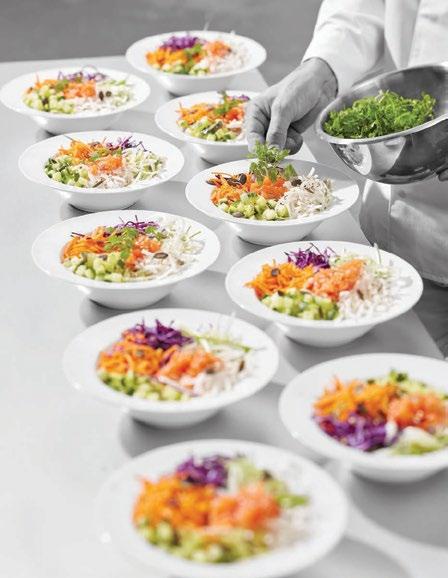
For Ernesto Castillo, director of Food and Beverage for the InterContinental Toronto Centre, choosing a pizza oven was all about efficiency and labour savings. When it came time to replace three smaller pizza ovens in his kitchen, he decided the best route would be a conveyor-style alternative — in this case a Lincoln countertop model.
“The three we had could only make one pizza at a time and you always had to keep an eye on them. It got challenging for one person to handle,” he explains.
Because it was so labour intensive, pizza
was only available for room-service orders. “The new conveyor is a dream,” he says. “You get the dough, build the pizza, put it on the conveyor, and four minutes later you cut it and box it. The beauty of it is that it all comes out the same way. You don’t have to worry about quality or burnt pizza.”

The added efficiency means they can now make enough pizzas to expand service to the hotel’s restaurants and bars. “We have easily tripled our sales for pizzas, and we don’t have to waste product anymore.”
OLD MEETS NEW
Gino Benevenga, owner of Venga Cucina in the junction in Toronto, is one of a rare company of chefs in the country to have perfected the art of Pinsa Romana, an alternative form of pizza that requires specific techniques and a high temperature to achieve the light, crispy, bubbly crust.
While a wood-burning oven would seem the obvious choice, “The floor simply couldn’t support one,” he says. Instead, he opted for a Moretti Forni double-deck gasfired oven that can cook up to 10 pizzas at a time.

“The beauty of the Moretti is that the stone has holes designed to allow hot air to circulate around the bottom of the pizzas without letting the flame get through,” he says.
Benevenga was also careful in his mixer selection, opting for a Mecnosud doublespeed spiral mixer. “It incorporates a lot of air when you do the mixing,” he explains.
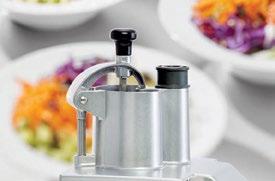
48 FOODSERVICE AND HOSPITALITY SEPTEMBER 2023 FOODSERVICEANDHOSPITALITY.COM
“The dough is so dense you need a pretty strong mixer that can mix without heating the dough.”
ALL THINGS TO ALL PIZZAS
When Tommy Schneider opened Tommy’s
Pizzeria in Winnipeg in January 2020, he wanted a pizza oven that could cater to all the styles of pizza he wanted to try, from Detroit and New York to Grandma and American style.
After checking out multiple options,
he went with a $55,000 Pizza Master 943, a four-stone hearth, three-deck modular electric pizza oven that can run at different temperatures at the same time. On a busy day, Schneider says he can cook more than two dozen pizzas at once.
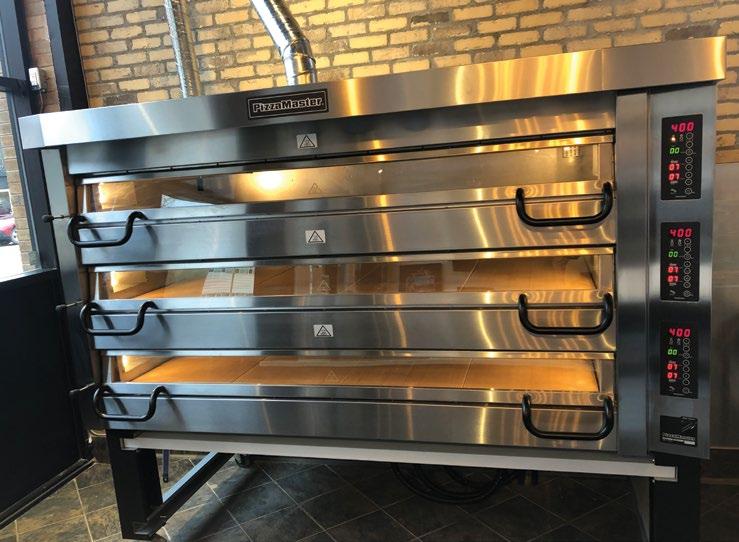




“I’ve worked around a few different types of pizza ovens, from gas-fired to wood burning,” he says. “This one gives me the ability to make so many different styles.”
Rounding out his equipment is an Infrico granite-top refrigeration system and a Cuppone multiple-speed spiral mixer. A couple of his favourite accessories are his GI Metal pizza peels and cutters. “All that equipment makes a difference. If you use peels that don’t have perforation holes, you end up with too much flour.”
Schneider, who has been making pizzas since the age of 15, is a firm believer in experimentation. “There are at least 30 styles of pizza so there’s always something to try. That’s why I love what I do. I never run out of things to learn.” FH
For all your PIZZA & PASTA SOLUTIONS


SEPTEMBER 2023 FOODSERVICE AND HOSPITALITY 49 FOODSERVICEANDHOSPITALITY.COM
MULTIPLA Combination Pasta Extruder and Ravioli Machine ICON Finish The world’s most powerful & advanced electric ovens. FAEMA.CA TORONTO SHOWROOM 672 DUPONT STREET – Toll Free : 877.323.6226

50 FOODSERVICE AND HOSPITALITY SEPTEMBER 2023 FOODSERVICEANDHOSPITALITY.COM POURING FOR PROFITS
New opportunities abound in the coffeeand-tea segment
 BY MORAG MCKENZIE
BY MORAG MCKENZIE
s restaurants opened to full capacity and the tourism industry rebounded, total year-over-year (YOY) coffee and tea consumption grew 11 per cent in 2022-2023. This impressive growth is primarily driven by an increased demand for cold specialty coffee and tea, and varies significantly by daypart and demographic. It’s also driven by consumers seeking unique flavours, health benefits and beverage convenience.
SEPTEMBER 2023 FOODSERVICE AND HOSPITALITY 51 FOODSERVICEANDHOSPITALITY.COM







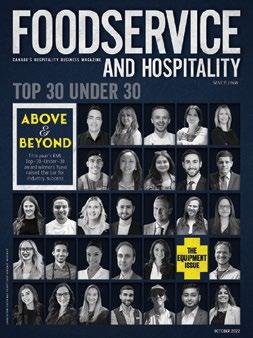
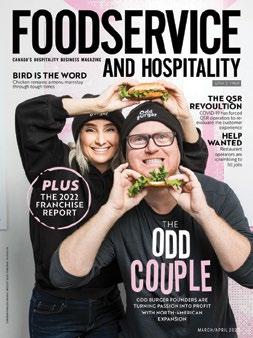
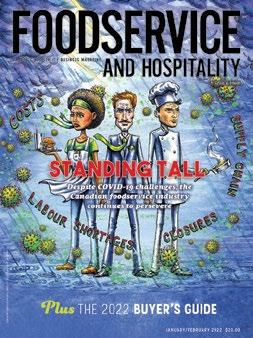

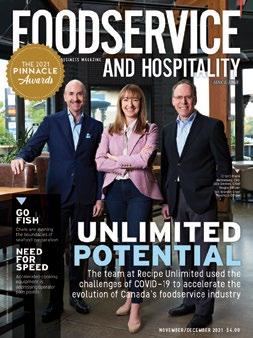
reprints For article reprints, permissions and content licensing contact: Danna Smith at dsmith@kostuchmedia.com
Tim Hortons continues to dominate the coffee market, reporting strong revenue growth in 2022. Canadian operations grew 13 per cent to reach $6.03 billion in sales. “We rebounded strongly in 2022 with comparable sales up 11 per cent in the fourth quarter, benefitting from strong sales momentum,” says José Cil, CEO of

parent company, Restaurant Brands International.
BREWED COFFEE DOMINATES THE MARKET
A Technomic January 2023 report states coffee-beverage purchases in 2022-2023 more closely resemble pre-pandemic behaviour. “While overall volume has decreased, hot brewed coffee continues to make up the largest share of the coffee market (65 per cent) followed by hot specialty (15 per cent) and cold specialty (20 per cent) coffee. The tea market is similar with hot (57 per cent) followed by hot specialty (14 per cent) and iced at 29 per cent,” explains Vince Sgabellone, a foodservice industry analyst, at Circana

He adds, “While hot brewed coffee (55 per cent) and tea (37 per cent) continues to dominate the morning market, the fastest-growing daypart for both coffee (24 per cent) and tea (28 per cent) sales is afternoon/snack. This has mainly been driven by the shift to remote work as people look

for a ‘mid-day re-energizer break’.”
With 29 per cent of all coffee purchased through a drive-thru, this segment continues to be very important to QSR operators, particularly in the morning daypart. “Drive-thru continues to be dominated by Tim’s (60 to 70 per cent) and McDonalds as


C OMPLETE AUT OMATION OF Y OUR C OFFEE PROGR AM
With growing competition across foodservice, operators need new technologies that increase coffee quality and also eliminate operational pain points.
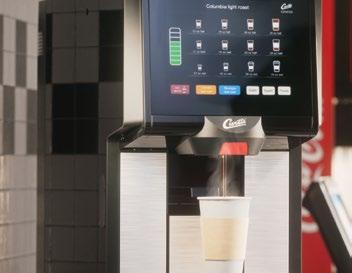

The first machine of its kind, the Curtis Genesis Skyline automates coffee output based on demand so restaurants serve the correct amount of coffee during every daypart.

Fresh Coffee. Maximum Speed. Reduced Labor. Minimized Waste. Operational Efficiency. Automated Cleaning.

wmf-coffeemachines.com • schaererusa.com • wilburcurtis.com
INCLUDES UNIQUE FLORAL, CITRUS AND SPICE COMBINATIONS


Pump Up Your Cold Brew

Made with rich maple and real cold-extracted coffee, Monin Maple Pumpkin Cold Brew delivers on sensational seasonal flavour.

Canadians’ morning coffee purchase decision are driven by convenience,” explains Robert Carter, president of Coffee Association of Canada.

COLD COFFEE AND TEA ARE HOT SELLERS



The fastest-growing coffee category is cold coffee, which includes frozen, slushiebased, iced or cold-brew coffee beverages. “Cold coffee

consumption is up 33 per cent over the last five years, including double-digit growth in the last year. While the large QSR chains have played a very large role in this growth, the real innovation comes from the independents, explains Carter. “Unique flavourings, toppings, colourings and even milk alternatives are where the growth opportunity is,” he adds.
A great deal of this growth
Non GMO l Gluten Free l Kosher
No Artificial Colours l Dairy Free

FOODSERVICEANDHOSPITALITY.COM
monin.ca @monin.can
“
”
POST COVID, TEAS THAT AID FUNCTIONAL HEALTH, EMOTIONAL RELIEF OR ARE ORGANIC HAVE SEEN SIGNIFICANT GROWTH. THIS
Shabnam
Weber
president
of Tea and Herbal Association of Canada (THAC)
is spurred by Gen Zs who are starting to drink coffee and tea at a much younger age. It’s this demographic that is dramatically affecting change in the cold coffee and tea category as they offer a very good vehicle for the innovative flavours they crave. “Gen Z grew up with bold flavours, so they’re looking for those in their LTOs and cold brews. Flavour preferences vary by demographic, including maple pumpkin, florals and herbal, with growing interest in coconut and global spices. Another great growth opportunity is combining syrups to create a blend that is unique to their operation,” explains Carrie
Gillespie, Field Sales Marketing


Coffee Gets Social
foam, garnish, flavoured topping or ability to customize,” states Kathy Perrotta, VP, IPOS. Full-service operators have an additional opportunity to make them even more appealing by adding in a unique garnish such as dehydrated fruit, glassware or even smoky presentation. They can also make them interactive as customers add something to their own beverage. Market forecasters predict double-digit growth to continue over the next three to five years. Cold specialty coffee continues to be perceived as a small but affordable indulgence, so even in inflationary time we predict strong growth to continue. New innovation combined with even younger generations entering the market make this beverage category one that all foodservice operators will want to continue to focus on,” states Perrotta.

SEPTEMBER 2023 FOODSERVICE AND HOSPITALITY 55 FOODSERVICEANDHOSPITALITY.COM FAEMA.CA NOW WITH Autosteam Pioneering the espresso experience in Canada for over 65 years! Available in 1, 2 and 3 group models Proudly Introducing a Reimagined Icon from the ’70’s. Toll Free 877-323-6226
manager at Monin, adding she also sees growing interest in zerosugar syrups.
Second Cup Canada has responded to this growing trend, adding a complete line of specialty hot and cold coffees and teas to its traditional premium brewed coffee. “We infuse the flavour into the beans versus adding a flavoured syrup to our beverages. Cold-brew coffee includes a fresh shot of our signature expresso. Top sellers include Ice Mixes (Expresso or Mocca Frappé) and Cold Infusions
From the Supply Side
For most brewed-coffee lovers, the ideal cup of coffee is brewed on demand. Yet, how does a busy QSR provide this same quality during peak rushes?
Curtis, a leading provider of commercial brewing systems has recently introduced the Curtis Genesis Skyline which allows operators to serve either bean-to-cup coffee or freshly brewed via an urn during busy rush periods.


"Speed of service and quality are crucial in today’s market. The Curtis Genesis brews fresh from whole beans, whether by cup or into the urn,” explains Harold Ooft, head of Sales, SEB Professional Canada.
(Vanilla Bean or Oatmilk Mocca),” explains Deena Nezirevic, senior manager, Category & Innovation for Second Cup. She adds, “Second Cup has also successfully introduced many seasonal LTOs.”
FUNCTIONAL HEALTH BENEFITS FUEL TEA GROWTH
Tea consumption in foodservice operations continues to see steady growth of 10 per cent, primarily fuelled by growth in herbal and Macha teas, which grew 19 per cent, while specialty-tea revenues, which includes London Fog, Chai et cetera, remains flat.

“While Boomers gravitate to traditional blends, millennials and Gen Z want more variety, including unique flavours and
recipes. The big QSR chains have brought a lot of innovation in this area, making London Fog, Chai Latte and unique flavour blends such as Pumpkin Spice almost mainstream,” explains Shabnam Weber, president of Tea and Herbal Association of Canada (THAC).
While 60 per cent of tea served in foodservice operations is hot, the greatest growth opportunity remains in iced and herbal teas that offer additional wellness benefits. “Post COVID, teas that aid functional health, emotional relief or are organic have seen significant growth. This includes unique floral, citrus and spice combinations,” adds Weber.
“Global flavours are also seeing significant growth as people are
During peak times, the machine brews large batches straight from whole beans into the urn, then stores it at 25, 50, 75 or 100 per cent full. Once demand has waned, programming switches to bean-to-cup mode; maximizing speed and minimizing waste. Additionally, daily cleaning of the machine is automated via calendar programming.
“It can brew two different types of coffee, decreasing waste and increasing operating efficiency. It is also very fast, dispensing a 16-ounce coffee in as little as 10 seconds when on urn mode and 40 seconds on bean to cup mode,” adds Oft.
Measuring only 13-inches wide and 23 inches deep, its countertop design allows for multiple machines to meet the heavy demand of larger foodservice operations. Available in Canada, the Curtis Genesis Skyline offers the quality of bean-to-cup and speed of urn coffee production.
56 FOODSERVICE AND HOSPITALITY SEPTEMBER 2023 FOODSERVICEANDHOSPITALITY.COM
C M Y CM MY CY CMY K
SOLVE COFFEE WASTE & KEEP YOUR RECIPE

Consistently deliver your recipe to the morning rush with the Infusion Series® batch brewing platform. For the rest of the day, Fast Cup™ compliments your coffee program by delivering the same flavor profile with bean-to-cup.

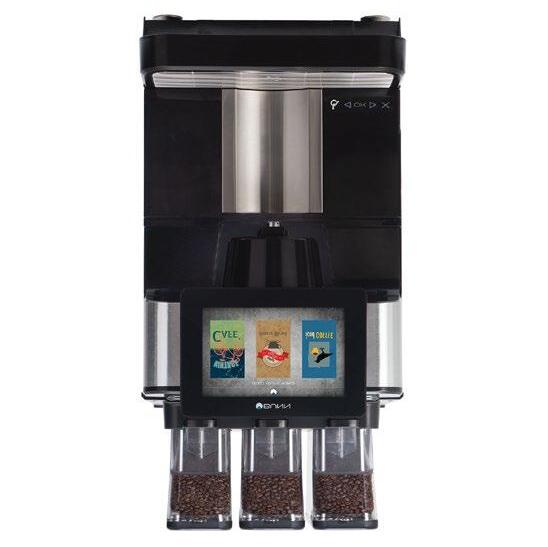
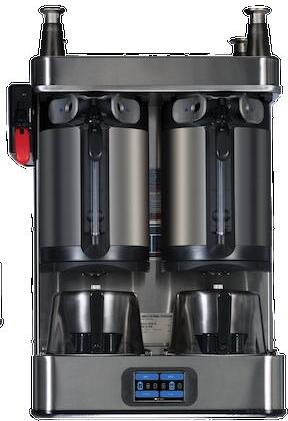
Ready to boost your profitability?
Let’s talk: www.bunn.com/daypartduo
looking for flavours from back home,” adds Sgabellone of Circana. Second Cup has seen significant growth from this trend, introducing its ‘Bloom Botanicals’ to its summer line up. “We have seen a growing interest in all the floral and fruit flavours, including lavender, hibiscus and lemony pear, many topped with a flavoured foam and garnish. A real advantage is many of the same ingredients can be used in multiple beverages,” explains Sam Wadera, VP Brands for Second Cup.
REVENUE AND GROWTH OPPORTUNITIES
Currently, specialty cold beverage revenues are dominated by QSR’s. “Full-service restaurants have an enormous opportunity to grow revenue through the introduction
of a greater variety of unique specialty cold beverages,” states Sgabellone. Tea and coffee are also increasingly being used as the base for alcoholic (i.e. Expresso Martini) and low alcohol or non-alcoholic cocktails, another growth opportunity for foodservice operators. Other opportunities to grow revenue are expanding coffee and tea food pairings. “We need to go beyond coffee-and-muffin pairings to offer creative food pairings and offer customers a unique experience,” states Kathy Perrotta, VP, Market Strategy at IPOS. She adds, “The functional and emotional health benefits of many specialty beverages also provide operators with an opportunity to talk about the

important holistic and natural energy they provide.”
There is also opportunity for QSR’s and full-service operations to grow coffee and tea revenues by daypart. “The morning daypart continues to be the fastest growing, offering an


excellent opportunity to expand cold specialty offerings during this time,” states Sgabellone
As coffee and tea are habitual purchases, they also lend themselves very well to digital online marketing and loyalty programs. FH
58 FOODSERVICE AND HOSPITALITY SEPTEMBER 2023
“
WE NEED TO GO BEYOND COFFEE-ANDMUFFIN PAIRINGS TO OFFER CREATIVE FOOD PAIRINGS AND OFFER CUSTOMERS A UNIQUE EXPERIENCE ”
Kathy Perrotta
FOODSERVICEANDHOSPITALITY.COM
VP, Market Strategy, IPOS
THE COMFORTS OF HOME, AWAY.
From the moment they check in, to the moment they check out, Mother Parkers Tea & Coffee has you covered.

FULL SERVICE AT YOUR SERVICE
We take care of your marketing, training and equipment so you can focus on your guests. Grow your business with us one cup at a time.
Let’s chat about your in-room, restaurant, and banquet options at mother-parkers.com/contact-us
A DASH OF SPICE
BY NICOLE DI TOMASSO
Hans Vogels says his first food memory was making beef stew in a pressure cooker with his grandfather.
Hailing from Moncton, N.B., the chef says, “Both of my grandfathers were influential in shaping my love for food. In fact, one of them was a WW2 veteran who helped liberate the other’s farmland…it’s a long story. They made me understand where our food came from and the work it took to get it to the table — from collecting eggs at the henhouse to digging clams on the North Shore.”
In highschool, Vogels’ passion for food materialized into action. “[During highschool], I washed dishes at a hotel, which exposed me to the rush of service and comradery of the kitchen,” he says. “This lit a fire in me and created a need to get on the right path for my future. This decision eventually led me to find my passion for the culinary arts.”
Following in his grandfather’s footsteps, Vogels joined the military as a tank driver for a few years before enrolling in a one-year culinary program at Holland College, P.E.I. and a two-year advanced program at The Culinary Institute of Canada in Charlottetown, P.E.I.
From there, Vogels re-located to Stratford, Ont. for an internship at The Church Restaurant, which eventually led him to Toronto in 2000 to work under acclaimed chefs Susur Lee and Marc Thuet at Susur and Bistro Thuet. After some time, Vogels landed a job at Momofuku Noodle Bar, where he stayed for 10 years and became the executive chef until the restaurant officially closed its doors in 2022. However, it wasn’t long before Vogels was contacted by Brandon Farmer and Matthew Tsoumaris of Honeycomb Hospitality Group to discuss a new concept they had been working on — DASHA.
“I’ve been fortunate to work with some highly talented chefs over the years, all of which have had an impact on the person I am today,” says Vogels. “Sheldon Russel at The Church was organized; Eric Vernice at the Bearfoot Bistro was creative; Susur Lee is a visionary; and Marc Thuet executes at the highest level. At Momofuku, I got the chance to put all these traits into a
formula, fostering a creative space that also focused on efficiency and accountability. At DASHA, I take the same approach.”
The 9,000-sq.-ft. venue provides cuisine and entertainment, with a panAsian menu that combines Chinese and Japanese influences, experiential cocktails and a hidden karaoke bar with five private rooms.
“Everything at DASHA is meant to be shared family style so [guests] are able to enjoy different flavours and textures. We wanted to create an exceptional sensory experience where guests can celebrate, enjoy, indulge and discover,” says Vogels.
BITS & BITES
Favourite ingredient to cook with?
Onions — crispy or raw, shallot or Spanish, caramelized or as a ring
Favourite culinary destination?
Oaxaca, Mexico and The Netherlands (Holland)
What do you cook at home?
“We have an offset smoker in the backyard and a fantastic butcher shop down the street, so lots of barbecue.”
Standout sharing items include Wok Rocked Shrimp ($32), featuring black tiger shrimp dusted in potato starch and tossed in the wok with Sichuan pepper oil, garlic and 1,000 chilies; Millionaire Fried Rice ($39) with the addition of black truffle, lobster and DASHA’s own Cantonese chili crisp; and Wagyu Steak ($125) from Mishima Reserve in Seattle, which uses the Japanese Kuroge Washu cattle breed.
“Mishima Reserve operates a carbon-neutral farm which we think is important to support,” adds Vogels.
This summer, Vogels says he has enjoyed using Ontario produce from local farmers and hosting the crowds of Toronto on DASHA’s patio.
Over the years, Vogels has proven adaptability is key in a professional kitchen. “I’ve been exposed to a range of managing styles, culinary disciplines, sizes of operations and ownership styles,” he says. “I’m comfortable finding the common ground in any situation and creating opportunities that can be leveraged as a team.”
In the future, Vogels imagines a partial retirement on the west coast of Mexico. FH

60 FOODSERVICE AND HOSPITALITY SEPTEMBER 2023 FOODSERVICEANDHOSPITALITY.COM CHEF’S CORNER
Hans Vogels proves adaptability is key




Visit today. www.foodserviceandhospitality.com foodserviceandhospitality.com 5 Reasons to visit Polls on important topics 5 1 News from across the industry 2 Exclusive Content 3 Videos and podcasts 4 Calendar of coming events foodserviceandhospitality.com
Rowe Beef Brings Award Winning

Local Flavour to Your Customers
When you want a really GREAT STEAK, Start with a really GREAT STEAK
THE HIGHEST QUALITY BEEF IS PRODUCED BY:



4nutritionally balanced feed ration


4high quality feed ingredients

4monitoring animal health
4low stress handling practices
4sustainably raised on Ontario family farms
Scan QR code to learn more
ITI Chef Panel Comments:



• Rich, full taste that is full of flavour.

• A succulent, tasty meat that stimulates salivation.

• A delicious steak with an authentic, natural flavour.


rowebeef.ca WELLINGTON COUNTY PREMIUM BEEF












































































































































































































































 BY LAURA PRATT
BY LAURA PRATT














 BY NICOLE DETLOR
BY NICOLE DETLOR








































 BY MORAG MCKENZIE
BY MORAG MCKENZIE





























































